
About UsThe Numismatic Bibliomania Society is a non-profit organization devoted to the study and enjoyment of numismatic literature. For more information please see our web site at coinbooks.org SubscriptionsThose wishing to become new E-Sylum subscribers (or wishing to Unsubscribe) can go to the following web page link MembershipThere is a membership application available on the web site Membership Application To join, print the application and return it with your check to the address printed on the application. Membership is only $20 to addresses in the U.S., $25 for First Class mail, and $30 elsewhere. For those without web access, write to: David M. Sundman, Treasurer
AsylumFor Asylum mailing address changes and other membership questions, contact David at this email address: dsundman@LittletonCoin.com SubmissionsTo submit items for publication in The E-Sylum, just Reply to this message, or write to the Editor at this address: whomren@gmail.com BUY THE BOOK BEFORE THE COINSale Calendar |
- WAYNE'S WORDS: THE E-SYLUM JUNE 7, 2015
- WERNER STENSGARD OFFERS NUMISMATIC LITERATURE
- NEW BOOK: MERCURY DIMES, STANDING LIBERTY QUARTERS, AND LIBERTY WALKING HALF DOLLARS
- NEW BOOK: CHECK LIST OF UNITED STATES AND CANADIAN COINS
- NEW BOOK: THE LONDON MINT OF CONSTANTIUS & CONSTANTINE
- NEW BOOK: XXI CENTURY COINS OF NEPAL 2015
- BOOK REVIEW: COIN COLLECTING ALBUMS V1
- FELT PLATE IMAGES USED TO MAKE WYATT COPIES
- COLONIAL WILLIAMSBURG'S NUMISMATIC COLLECTION
- NOTES FROM E-SYLUM READERS: JUNE 7, 2015
- MISSING PRINTS FOUND AT BOSTON PUBLIC LIBRARY
- NUMISMATIC AUCTIONS AS EVENTS
- CUT-CANCELLED TREASURY CHECKS 1819-1834
- SECOND U.S. MINT TREE RELIC
- MORE ON THE COREY'S OINTMENT COUNTERSTAMP
- NEW RESEARCH ON THE EVERMAN COUNTERSTAMP
- MAKING MONEY WITH JEFFERSON NICKELS
- MORE ON OBVERSES AND REVERSES
- BALTIMORE'S WASHINGTON MONUMENT TIME CAPSULE OPENED
- SELECTIONS FROM NUMISMATIC AUCTIONS SALE 57
- SELECTED CIVIL WAR TOKENS FROM STEVE HAYDEN
- HEEREN FAMILY BACKGROUND ON THE COLUMBIA SHIELD
- QUERY: WERE TOKENS USED IN THE KALAUPAPA LEPER COLONY?
- DIX NOONAN WEBB SEPTEMBER 2015 AUCTION SALES
- BALDWIN'S OFFERS WATERLOO MEDALS
- SELECTIONS FROM PRESIDENTIAL AUCTION #85
- QUERY: WHAT DOES THIS MEDALET'S INSCRIPTION MEAN?
- SOME RECENT COIN DESIGNS: JUNE 7, 2015
- QUERY: AUSTRALASIAN BANK CHEQUE INFORMATION SOUGHT
- MAO CHIN MARK MAKES A VALUABLE ERROR BANKNOTE
- 2015 CURRENCY CONFERENCE A RETROSPECTIVE
- G7 MINISTERS VISIT GERMANY’S ANCIENT COIN COLLECTION
- EXHIBIT EXPLORES MEDALS OF LOUIS XIV
- KÜNKER 2015 SUMMER AUCTION HIGHLIGHTS
- CHINESE BUSINESS BUYS CAR USING 660,000 COINS
- FEATURED WEB PAGE: SCOUTING THEME MEDALS
Click here to access the complete archive
To comment or submit articles, reply to whomren@gmail.com
WAYNE'S WORDS: THE E-SYLUM JUNE 7, 2015

New subscribers this week include: Bob Yarmchuk, Ken Fritsch, and Hugh Cloke. Welcome aboard! We now have 1,846 subscribers.
This week we open with a Swedish dealer's numismatic literature offering, four new books and one review. Other topics include the Wyatt copies, Treasury checks, event auctions, U.S. merchant counterstamps, Civil War tokens, leper colony tokens, the Columbia Shield, Waterloo medals, a Chalmers Shilling love token, and Australasian bank cheques.
To learn more about Fred Zinkann's patterns, the coins of Nepal, obverses and reverses, coin collecting albums, the Chautauqua Movement, Eureka Pile Ointment, 1815 Large Cents, gold Pistoles, the Grover Cleveland satirical inaugural token, and exploding bomb medals, read on. Have a great week, everyone!
Wayne Homren
Editor, The E-Sylum

WERNER STENSGARD OFFERS NUMISMATIC LITERATURE
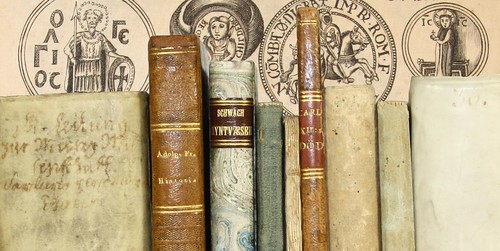
I'm an antiquarian bookdealer in Sweden specialized in numismatic and history. The readers of The E-Sylum could most likely be interested in my stock. Right now there´s about one hundred books online. Searchable here.. http://www.antikvariat.net/search.cgi?qx=new&sq=ste&la=sv&cu=sek&ht=ft&bg=FFF8DC&bg2=DEB887
(Yes, it looks like something made in DOS from the early nineties). A complete new database and website is in the making and will be launched soon. Then I will add a few hundred titles of numismatics as well as pictures. When the new website is launched it will be advertised in other media as well. So take a look now before others get the news.
Don’t hesitate to send me inquiries regarding numismatics, old books and manuscripts. The complete stock will never be online so send me an email of your interests.
Also see my website www.wernerstensgard.se
NEW BOOK: MERCURY DIMES, STANDING LIBERTY QUARTERS, AND LIBERTY WALKING HALF DOLLARS
Standing Liberty Quarters, and Liberty Walking Half Dollars
by Dennis Tucker
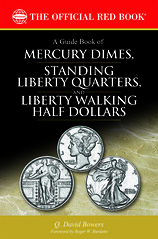 The
first volume of the “Bowers Series” of numismatic references—the Guide Book of Morgan Silver Dollars—was published in 2004. As of
early 2015 that initial volume plus the ones that followed it have comprised more than 5,000 pages of information on U.S. copper half cents
through gold double eagles, Proof sets, commemorative coins, tokens and medals, and other numismatic collectibles. To that impressive
lineup, volume 18 adds three of the most popular U.S. coins ever minted—the Mercury dime, the Standing Liberty quarter, and the Liberty
Walking half dollar.
The
first volume of the “Bowers Series” of numismatic references—the Guide Book of Morgan Silver Dollars—was published in 2004. As of
early 2015 that initial volume plus the ones that followed it have comprised more than 5,000 pages of information on U.S. copper half cents
through gold double eagles, Proof sets, commemorative coins, tokens and medals, and other numismatic collectibles. To that impressive
lineup, volume 18 adds three of the most popular U.S. coins ever minted—the Mercury dime, the Standing Liberty quarter, and the Liberty
Walking half dollar.
The popularity of these three coin types has long been on our radar at Whitman Publishing. How could it not be? Collectors have bought thousands of Whitman blue folders and albums to save one coin from every date and mint. We get phone calls and letters asking about the coins and their die varieties, how to grade them, and how much they’re worth. Until now, we’ve referred our readers to the Guide Book of United States Coins (the hobby’s “Red Book,” which covers every U.S. coin series), to various books that describe grading or that study one or another of the individual coin types, or, for more detailed exploration of die varieties, to the Cherrypickers’ Guide. Now collectors have another standard reference, one that brings everything together in a single resource: the Guide Book of Mercury Dimes, Standing Liberty Quarters, and Liberty Walking Half Dollars.
The decision of how to present these coins to the hobby community wasn’t lightly made. Our intent with the Bowers Series is to study the most popular coin types in books that are affordable, logically organized, and valuable to the reader. These goals brought certain questions to the fore. By 2014, we had no Bowers Series book on dimes, one on quarter dollars (the Guide Book of Washington and State Quarters), and one on half dollars (the Guide Book of Franklin and Kennedy Half Dollars). Would it make sense to create a Guide Book of Mercury and Roosevelt Dimes, covering the last 100 years of that denomination in a single reference? And what to do with the Standing Liberty quarter? Modern quarters, of 1932 to date, were already accounted for, and we knew we would be covering Barber silver coins (dimes, quarters, and halves) all together in a single upcoming volume. That left the Standing Liberty quarter somewhat orphaned—a relatively short series spread over a span of 15 years, comprising fewer than 40 major date/mintmark varieties, certainly not enough to fill their own 300-page book. A similar question lingered for half dollars, with the Bowers Series already covering that denomination from the present day back to 1948.
I believe our final decision—to present these three coins together in a single volume—is a sound one. Mercury dimes, Standing Liberty quarters, and Liberty Walking half dollars were all part of the elegant “Renaissance of American Coinage” (as Roger W. Burdette termed it in his award-winning book series), the early-1900s rebirth of great U.S. coin design. All three were workhorses of American commerce in their heyday, which spanned from 1916 into the 1940s, from a world war to a gilded age of progress, then through the depths of an unprecedented economic depression and a second global conflagration.
The motifs of these working-class coins are widely ranked among America’s greatest numismatic designs. They speak to the viewer in a way that the older, grim-faced Barber coins never did, in a way that today’s modern presidential-portrait coinage certainly doesn’t. Their appeal is not just the sentimental feeling they invoke, and it’s not just the vibrancy and action of their designs; it’s a combination of everything about them, their ineffable sense of history as well as their old-fashioned but still very robust physicality. We look at them and we think, This is the United States of America.
If a Grandpa of a certain age had a cigar box or candy dish that he tossed his pocket change into, chances are good it held a few of these silver pieces. Today they are commonly found in inheritances of old coins—perhaps studiously assembled and proudly displayed, perhaps jumbled haphazardly with vintage bus tokens, World War II ration tokens, and other pocket change. To the community of active hobbyists they are solid “collector” coins, sought by thousands of enthusiasts. Casual collectors fill the holes in their blue folders, eagle-eyed specialists seek out the scarcer die varieties, and deep-pocketed aficionados compete to build the finest registry sets.
For all these reasons—the historical connection of the three coins, their representation of an important generation and era, their unique place in the wider world of American numismatics, and their longstanding popularity among coin collectors and the general public—we decided to combine them into a single standalone book for collectors and historians.
Naturally the perfect author for this subject was Q. David Bowers himself, the “Dean of American Numismatics,” after whom the Bowers Series is named. The most widely published numismatic author and researcher of recent generations, Bowers marshals his resources to bring his readers technical, historical, and market-oriented knowledge unavailable in any other single book. The Guide Book of Mercury Dimes, Standing Liberty Quarters, and Liberty Walking Half Dollars is the culmination of more than 50 years of research and study, designed to immerse you in the world of these fascinating coins, make you a smarter and more savvy collector, and prepare you to build the greatest coin collection possible.
A Guide Book of Mercury Dimes, Standing Liberty Quarters, and Liberty Walking Half Dollars
By Q. David Bowers; foreword by Roger W. Burdette
Debuting on the 4th of July, 2015
ISBN 079484314-X
Perfectbound softcover, 6 x 9 inches
320 pages
Full color
Retail $29.95 U.S.
For more information, or to order, see:
A Guide Book of Mercury Dimes, Standing Liberty Quarters, and Liberty Walking Half Dollars, 1st Edition
(www.whitman.com/store/Inventory/Detail/A-Guide-Book-of-Mercury-Dimes-Standing-Liberty-Quarters-and-Liberty-Walking-Half-Dollars-1st-Edition+079484314X)
NEW BOOK: CHECK LIST OF UNITED STATES AND CANADIAN COINS
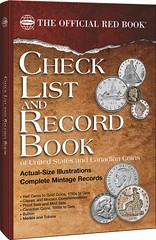 Whitman Publishing announces the release of the new Check List and Record Book of United
States and Canadian Coins, a resource to help collectors keep track of their coins. The 272-page perfectbound book debuts June 30,
2015, and will be available from booksellers and hobby shops nationwide. In the meantime it can be preordered online, including at
www.Whitman.com, for $9.95.
Whitman Publishing announces the release of the new Check List and Record Book of United
States and Canadian Coins, a resource to help collectors keep track of their coins. The 272-page perfectbound book debuts June 30,
2015, and will be available from booksellers and hobby shops nationwide. In the meantime it can be preordered online, including at
www.Whitman.com, for $9.95.
The Check List and Record Book of United States and Canadian Coins is a convenient way to keep track of a coin collection. Its 6 x 9–inch size packs a large amount of information into a handy resource that can be carried in a pocket or bag, or stored in a safe deposit box. Collectors take the book to coin shows and shops while they’re on the hunt for new numismatic acquisitions, checking each box as they add a coin to their collections or upgrade to a better specimen. The book also has room to write notes on when and where various coins were bought, their grades, pricing, and any other information the collector wants to record.
The Check List and Record Book features actual-size illustrations of each coin type, complete mintage records for circulation-strike and Proof coins, and coin-by-coin listings of every date and mint. The coins covered include U.S. half cents through gold double eagles, 1790s to date; classic and modern commemorative coins; government-issued commemorative sets; Proof sets and Mint sets; Canadian coins from the 1850s to date; and silver, gold, and platinum bullion coins. There are sections to keep track of collections of Hard Times tokens; Civil War tokens; other tokens and medals; Hawaiian coins; Puerto Rican coins; coins struck for the Philippines under U.S. sovereignty; misstrikes and error coins; and American Arts gold medallions. The Canadian chapters cover large cents; small cents; five-cent pieces; silver and modern coins; commemorative issues; dollar coins; and bullion pieces.
“Keeping an accurate inventory of your coins is one of the most important things you can do as a collector,” says Whitman publisher Dennis Tucker. “Not only does it help you organize and build a better collection, it can also be useful for tax and insurance purposes, and as a valuable record for your children and grandchildren to learn about your collection.”
The new Check List and Record Book covers coins and coin sets up through 2015, with extra space to keep track of later coins.
Check List and Record Book of United States and Canadian Coins
ISBN 079484365-4
Perfectbound softcover, 6 x 9 inches
272 pages
Retail $9.95 U.S
For more information, or to order, see:
Check List and
Record Book of United States and Canadian Coins
(www.whitman.com/store/Inventory/Detail/Check-List--Record-Book-of-US-Coins-and-Canadian-Coins-+0794843654)
NEW BOOK: THE LONDON MINT OF CONSTANTIUS & CONSTANTINE
Author Lee Toone writes:
I now have details of the publication of my book. Spink are now taking preorders and delivery will be at the end of June.
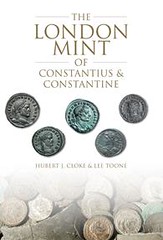 The London Mint of Constantius & Constantine
The London Mint of Constantius & Constantine
by Cloke, H. J. & Toone, L.
THIS BOOK IS AVAILABLE FOR PREORDER.
This book is a comprehensive catalogue and survey of the output of the London mint from AD 296 when Constantius I invaded Britain to wrest the 'Britannic Empire' from Allectus, to its closure in 325 when his son and successor, Contstantine I, began to shift his power base to the East/ During this period the London mint was responsible for a vast output of Roman coinage.
The authors of this book have expanded the number of known London types from the 617 recorded in Volume VI and VII of The Roman Imperial Coinage (RIC), to 1,037, 90 per cent of which are illustrated on plates facing the catalogue tables in sylloge format.
Supported with historical background narratives, indices, and a concordance with RIC, the catalogue also includes a hoard census which lists numbers of coins for each type found in four major hoards. This enables an objective rarity value to be assigned to each coin type.
This book proposes to become the standard reference work on the London mint for years to come and invites the reader to become part of the on-going construction of this catalogue as new types are discovered and recorded.
Our Price: 50.00
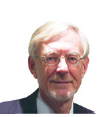 Hugh Cloke received his Ph.D. in literature from the University of
Chicago and was, for forty years, a faculty member and administrator at Georgetown University in Washington, D.C. His research and teaching
interests focused on the role of Roman ruins in the works 18th and 19th-century American writers and visual artists and extended to coinage
through the chance purchase of a small Constantinian bronze for his son in 1992. Over the intervening twenty years his interests in the
coinage of the Tetrarchic period have evolved from collecting to researching their history and constructing a narrative that makes these
objects intelligible. The present work is the result of a six-year collaborative effort with Lee.
Hugh Cloke received his Ph.D. in literature from the University of
Chicago and was, for forty years, a faculty member and administrator at Georgetown University in Washington, D.C. His research and teaching
interests focused on the role of Roman ruins in the works 18th and 19th-century American writers and visual artists and extended to coinage
through the chance purchase of a small Constantinian bronze for his son in 1992. Over the intervening twenty years his interests in the
coinage of the Tetrarchic period have evolved from collecting to researching their history and constructing a narrative that makes these
objects intelligible. The present work is the result of a six-year collaborative effort with Lee.
 Lee Toone has been involved in numismatics for over forty years. For
the last thirty of these he has concentrated on Roman numismatics and numismatic books. He is now a full time numismatist and owner of
Hookmoor Ancient Coins. He has previously published several papers on the London mint of Constantine. He is currently working on a
collectors’ guide to Romano-British coinage that will be a much needed update to Gilbert Askew’s The Coinage of Roman Britain. He
would be grateful for any contributions of new material towards this project.
Lee Toone has been involved in numismatics for over forty years. For
the last thirty of these he has concentrated on Roman numismatics and numismatic books. He is now a full time numismatist and owner of
Hookmoor Ancient Coins. He has previously published several papers on the London mint of Constantine. He is currently working on a
collectors’ guide to Romano-British coinage that will be a much needed update to Gilbert Askew’s The Coinage of Roman Britain. He
would be grateful for any contributions of new material towards this project.
For more information, or to order, see:
The London Mint of Constantius & Constantine by Cloke, H. J. & Toone,
L. (www.spinkbooks.com/product.php?xProd=537&xSec=47)
NEW BOOK: XXI CENTURY COINS OF NEPAL 2015
Pabitra Saha writes:
A revised edition of my eBook on XXI Century coins of Nepal is now online.
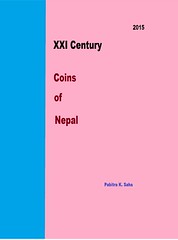 Nepal, a land locked country in South Asia, boasts of Himalayas, the highest mountain range in the
world. In addition, it has a rich legacy of nearly 4,000 year history of having never been conquered or rules by foreign powers. It is the
coins of this country, which became a democracy as late as 2007, that form the subject of this monograph.
Nepal, a land locked country in South Asia, boasts of Himalayas, the highest mountain range in the
world. In addition, it has a rich legacy of nearly 4,000 year history of having never been conquered or rules by foreign powers. It is the
coins of this country, which became a democracy as late as 2007, that form the subject of this monograph.
For more information, or to purchase, see:
XXI Century Coins of Nepal (https://books.google.com/books?id=N7v9CAAAQBAJ)

BOOK REVIEW: COIN COLLECTING ALBUMS V1
The other day I spent a pleasant few hours brushing up on the history of the Chautauqua Movement in America. You may or may not know that this started in 1874 at a camp on Lake Chautauqua near Jamestown in Upstate New York, as a course for Sunday school teachers. The idea of immersing one’s self in several days of learning had appeal, and by the 1890s several Chautauqua companies were traveling circuits in America in bookings arranged by agents. The typical circuit ranged from vaudeville and amusement to serious speakers on temperance, suffrage, labor unions, and more. The movement petered out in the early 1920s.
One of the most popular speakers was Russell Conwell, who is said to have given his “Acres of Diamonds” several thousand times. It is remembered today (by those who like and read history) as a motivational program—acres of diamonds (many opportunities) are all around you. All you need to do is pick them up.
The same can be said for numismatic books! Hardly an issue of The E-Sylum goes by without an announcement of one, two, or a handful of new books. No one can possibly buy or read them all.
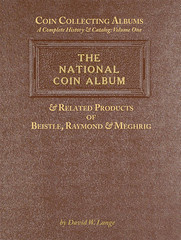 In my own life I endeavor to buy a copy of each important or interesting book on American numismatics. Sometimes I overlook a “diamond”
among the “acres” of texts available today. Such an instance happened last week when I acquired a copy of David W. Lange’s Coin
Collecting Albums, A Complete History & Catalog: Volume One, with the central or main title, The National Coin Album & Related
Products of Beistle, Raymond & Meghrig. Makes the title of A Guide Book of United States Coins seem simple. My overlooking took
the form of my not discovering it until a year after Dave Lange’s book was first published.
In my own life I endeavor to buy a copy of each important or interesting book on American numismatics. Sometimes I overlook a “diamond”
among the “acres” of texts available today. Such an instance happened last week when I acquired a copy of David W. Lange’s Coin
Collecting Albums, A Complete History & Catalog: Volume One, with the central or main title, The National Coin Album & Related
Products of Beistle, Raymond & Meghrig. Makes the title of A Guide Book of United States Coins seem simple. My overlooking took
the form of my not discovering it until a year after Dave Lange’s book was first published.
I love numismatic history. You may have copy of my American Numismatics Before the Civil War book published in 1998. This is the only book I have ever done for which the print quantity ordered, 1,000 plus a few overruns, was perfect. The book was advertised, all but a few copies sold right away, and we never received any other orders! Someday I might write a History of American Numismatics covering all eras. Marketing might be difficult now, what with the Internet and the like.
Book selling was different in the late 20th century. In 1979 when my The History of United States Coinage as Illustrated by the Garrett Collection was issued, the 4,000-copy print run was sold out in days, and eventually about 15,000 went to buyers. In 1988 when Walter Breen’s Complete Encyclopedia of United States and Colonial Coins was published my company sold over 10,000 copies the first year. But I digress. Back to the topic at hand.
Dave Lange’s book is rich with numismatic history from the late 1920s today. The sale of Raymond’s “National” albums was about 50% responsible for launching the rare coin market we know today. The other 50% credit goes to Whitman Publishing with its “Penny Boards.” Until the late 1920s there were no albums in which to easily store coins. Paper envelopes 2x2 inches square were the norm, or coins could be laid out in a thin drawer in a wooden cabinet.
M.L. Beistle changed that in 1928 with the invention of an album page made of thick cardboard, with round openings for coins and with clear cellulose acetate slides covering the obverses and reverses. You could watch and enjoy your collection as the holes were filled in one by one. These were licensed to Wayte Raymond who conducted the Scott Stamp & Coin Company in New York. Whitman on the other hand played to the lower end of the market. With a Whitman page at hand it was fun to look through coins in circulation and hope to find the Holy Grail, a 1909-S V.D.B. cent.
Both of these products started the date-and-mintmark procedure we know today. Believe it or not, in 1930 all Proof Liberty Head nickels were priced about the same. A gem 1909-S V.D.B. cent cost a dollar. By 1940 the rare 1885 stood out above all others. Another interesting aspect of the decade is that we were in the middle of the Great Depression. Rare coins were inexpensive, the new pages and albums made the hobby fun, and percentage-wise the greatest decade of price increases in numismatics took place!
With Dave Lange’s marvelous book at hand you can travel through the years and see how Wayte Raymond in particular was the foundation for advanced collectors. I treasure my copy as one of my favorite non-market books of our era (by non-market I mean that it does not list population prices, give auction records, or predict the price of gold, etc., etc.). Its assets are that it is interesting and informative.
Seeking to share my year-late enthusiasm I asked Dave Lange how his 288-page deluxe hardbound book could be ordered. I was informed that it was published at $75, but is now just $59.95 plus $10 Priority Mail shipping while remaining copies last. More from Dave L.:
“Buyers can pay via PayPal to my email address, langedw@msn.com, or by check made out to me at the address below. All books will be signed and/or inscribed, unless specified otherwise. I also offer my coin board book at half its publication price: $19.95 plus $5 shipping. If both books are ordered, a flat shipping fee of $10 will suffice.”
Full disclosure from me (the other Dave, Dave Bowers) in reverse: Writing this appreciation was my idea, and I have no benefit from any order you place. I will state, however, that you will enjoy the book or books when you receive them.
Dave Bowers
Wolfeboro Falls, NH
To read the earlier E-Sylum article, see:
NEW BOOK: COIN COLLECTING ALBUMS, VOLUME ONE
(www.coinbooks.org/esylum_v16n32a02.html)
FELT PLATE IMAGES USED TO MAKE WYATT COPIES
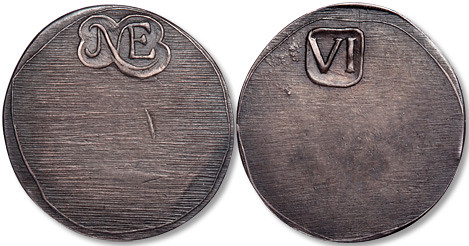
The second example of a NE sixpence shown above has a very curious story. Beginning in the 1850s, coin collecting in the United States grew greatly in popularity. Rarities could only be owned by a few collectors. So it was not surprising that several enterprising individuals decided to create their own imitations of rarities for sale to collectors. Some were sold as copies at reasonable prices, and some no doubt were fraudulently offered to collectors as genuine pieces. With only a couple of numismatic references of any note published, and with few illustrations and no photographs, it was easy pickings for the fraudulently inclined. The best-known examples today were those copies made in New York City by Thomas Wyatt and later by Edwin Bolen – to whom Wyatt sold the dies. These activities happened long before today's Hobby Protection Act, enacted in 1973 and requiring the word COPY to be placed on all imitation pieces.
If you compare the Wyatt copy to the photo of the genuine coin, you'll note the curious horizontal lines on the copy. What are they, and why would a person making a copy put them on the copy when they aren't on the original? As mentioned above, there were no photos of coins in books during these early days of U.S. numismatics. With very few examples of the rare New England coinage known, the copyist likely did not have access to the genuine article. The next best thing were the facsimile images of "Pine Tree Money" and New England coinage published in An Historical Account of Massachusetts Currency by Joseph B. Felt [1839]. The line images were roughly modeled after the images from Plate XXX in the 1745 book, A Table of English Silver Coins, by Martin Folkes of the Society of Antiquaries of London [January, 1745].
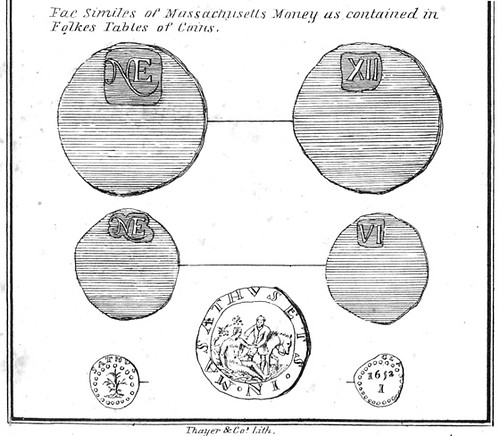
The Thomas Wyatt copies do not resemble the NE coinage images in Martin Folkes' earlier 1745 work published in London. Thomas Wyatt's copies are known to have existed as early as June 1856. He reportedly made a dozen copies of eight different early colonials and marketed them as sets of 8 different denominations of Massachusetts currency. These included some "copies" of coins that are really fantasies – for which genuine coins are non-existent. Newspaper accounts from Boston as early as 1856 mention their "discovery" in an old bottle, and their subsequent purchase "by a gentleman to be presented to the British Museum."
Not shown here but worth noting: the most expensive collectable copies of the NE coinage are contemporary counterfeits made in the 1650s. A few do exist, and when sold today, they can bring tens of thousands of dollars at auction from knowledgeable collectors.
To read the complete article, see:
Famous
New England Sixpence from the Royse Collection
(www.littletoncoin.com/webapp/wcs/stores/servlet/Display%7C10001%7C10001%7C-1%7C%7CLearnNav%7CFamous-New-England-Sixpence.html)
To read the earlier E-Sylum articles, see:
THE STRUCK COPIES OF THOMAS WYATT AND OTHERS
(www.coinbooks.org/esylum_v18n21a07.html)
NOTES FROM E-SYLUM READERS: MAY 31, 2015 : Numismata Antiqua
(www.coinbooks.org/esylum_v18n22a08.html)
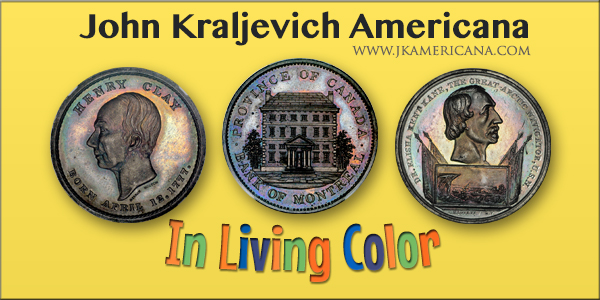
COLONIAL WILLIAMSBURG'S NUMISMATIC COLLECTION
Housed in the DeWitt Wallace Decorative Arts Museum in Colonial Williamsburg are numismatic gems in the world of colonial coinage, medals and currency. The exhibit "Dollars, Farthings & Fables" brings to life the currency and coins that were driving a young nation. These tangible assets from a distant past are displayed in a style that is both interesting and enlightening to all visitors of the museum.
Since he was a boy, Curator Mr. Erik Goldstein was obsessed with the American Revolution while simultaneously being a coin collector. Therefore, it was only natural that he began to study colonial currency and early American coinage. He prefers "coins with history" over pristine examples that have never had a life outside of a museum's coin cabinet. One of his favorite examples of this principle is a Virginia halfpenny that was unearthed on the grounds of the Governor's Palace at Williamsburg. By no means is it an unspoiled specimen, but if it could talk it would have a story to tell that would keep us spellbound for hours.
The numismatic exhibit is a fun exploration of coins and currency in early Colonial America. The display explores the "first, biggest, prettiest, ugliest, busted myths and personalities" in colonial coins and currency. The exhibit guides visitors on a journey from colonial times to the beginnings of our new nation. Examples of wampum and "hoe" money that were traded with the early American Indians before coins arrived on our continent from other countries are on exhibit.
Some of the other items you can see on display include a 1724 Brazilian 20,000 Reis gold coin, English farthing, 1652 Massachusetts "NE" Shilling, 1776 American Continental Dollar, gold doubloons, silver "pieces of eight", and a 1783 "Libertas Americana" silver medal brought back from France by Benjamin Franklin.
One of the most impressive displays is the Cornell Paper Money Hoard. This hoard of North Carolina colonial paper money was assembled by Samuel Cornell, a merchant and currency speculator in the period right before the Revolution. While not the entire hoard, this portion contains about 4,200 notes from the original 6,700 notes and represents about 4% of that colony's total output of paper money during the period from 1748 until 1771.
To read the complete article, see:
Colonial
Williamsburg's Collection Of Coins, Medals, and Currency
(http://coins.about.com/od/famousrarecoinprofiles/a/Colonial-Williamsburg-Collection-Of-Coins-Medals-And-Currency.htm)
NOTES FROM E-SYLUM READERS: JUNE 7, 2015
E-Sylum Ads Work!
Larry Korchnak writes:
A few weeks back I was reading The E-Sylum and I saw a Charles Davis ad. I decided to see if he had a copy of Mailliet plates, a companion to the classic work on siege coins. I have the text potion but have been seeking the volume containing the plates for many years. I was excited to see it in his inventory and promptly bought it. Thanks, Charlie and thanks E-Sylum.
The Buttoned-Down Mind of Dave Hirt
Regarding last week's discussion of how Dave Hirt recognized the numismatic significance of the 1746 book Numismata Antiqua.
Phil Carrigan writes:
I obtained a keen appreciation for Dave's mind from this experience!
To read the earlier E-Sylum article, see:
NOTES FROM E-SYLUM READERS: MAY 31, 2015 : Numismata Antiqua
(www.coinbooks.org/esylum_v18n22a08.html)
Query: Where to Purchase ‘Legends of Travancore’
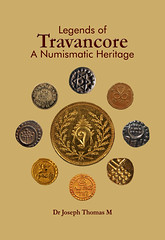 Philip Mernick writes:
Philip Mernick writes:
You mentioned a new book ‘Legends of Travancore’. Does anyone know how to obtain a copy? The publisher and Amazon India only seem to offer shipment within India. PrintsAsia.com doesn't have it. I have also emailed the university that published it, but so far without response.
To view the video, see:
Legends of Travancore - A Numismatic Heritage
(www.youtube.com/watch?v=HxkPmptnBUY)
To read the earlier E-Sylum article, see:
NEW BOOK: LEGENDS OF TRAVANCORE (www.coinbooks.org/esylum_v18n19a11.html)
Query: Handbook of Southern African Tokens
Yosef Sa'ar writes:
I have recently come across a reference to the following publication unknown to me: Brian Hern, Handbook of Southern African Tokens. 2009. I would greatly appreciated a review and/or information about the publisher and how to obtain it.
DAMIN Conference Proceedings Available
Georges Depeyrot writes:
The proceedings of the DAMIN Copenhagen conference on Mints, Technology and Coin Production (May 28-29, National Museum of Denmark) is now in press and will be available in July. You can have a look to the volume on www.moneta.be/volumes/moneta_191.htm
Georges adds:
You can find a complete catalogue of the 191 Moneta volumes from the first volume (1995) to the last one (2015) at www.moneta.be/pages/Moneta_Catalog_web.pdf The volumes are listed by periods and by regions, from Antiquity to 20th c. with a special list in relation with the DAMIN program.
Stack’s Bowers Seeks Numismatic Writer
An E-Sylum reader inquired about a recent string of ads. He writes:
Stacks/Bowers has been advertising for MANY months, looking for a Numismatic Writer. Has there been interest? It seems like a golden opportunity to turn a hobby into a career!
My friend Eric Schena signed on as a cataloguer a while ago, and he's really enjoying it. I reached out to the company, and Stack’s Bowers President Galleries Brian Kendrella writes:
"We have gotten strong interest in the position and as you mention, Eric Schena has been doing some cataloging for us for quite some time now. We are always looking for cataloging talent and so have kept the solicitation on our newsletter. If we found someone with the right attributes we would certainly look to bring them on board."
1856 British Guiana One-Cent Magenta Stamp Displayed
Regarding an exhibit at the Smithsonian's National Postal Museum in Washington, D.C., Les Rosenbaum writes:
Although philatelic, rather than numismatic, this may interest all, especially since it will be on display through Nov. 2017:
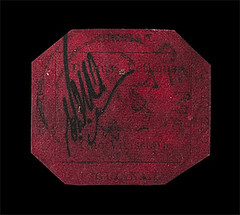 1856
British Guiana One-Cent Magenta
1856
British Guiana One-Cent Magenta
June 4, 2015 – November 2017
Museum: Postal Museum
Location: Level 2, William H. Gross Stamp Gallery
The National Postal Museum will display the world’s rarest postage stamp, the 1856 British Guiana One-Cent Magenta. The exhibition of the stamp will be the longest and most publicly accessible showing ever.
No postage stamp is rarer than the sole-surviving example of the British Guiana One-Cent Magenta. Printed in black ink on magenta paper, it bears the image of a three-masted ship and the colony’s motto in Latin: “we give and expect in return.” Noted for its legacy, the stamp was rediscovered by a 12-year-old Scottish boy living in South America in 1873, and from there passed through some of the most important stamp collections ever assembled. It is the only major rarity absent from the Royal Philatelic Collection owned by Queen Elizabeth II.
Note: The stamp will not be on view November 27 – December 9, 2015 and May 23 – June 10, 2016.
To read the complete article, see:
1856 British Guiana One-Cent Magenta
(www.si.edu/Exhibitions/Details/1856-British-Guiana-One-Cent-Magenta-5692)
Some Vaguely Numismatic Cheesecake
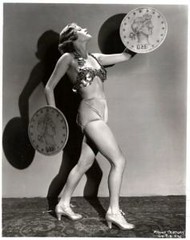 From
the vaguely-numismatic-but-a-great-excuse-to-include-vintage-cheesecake department, Arthur Shippee forwarded this image from the Obscure
Actresses blog. Thanks!
From
the vaguely-numismatic-but-a-great-excuse-to-include-vintage-cheesecake department, Arthur Shippee forwarded this image from the Obscure
Actresses blog. Thanks!
To read the complete article, see:
MAXINE CANTWAY (https://obscureactresses.wordpress.com/
2014/06/18/maxine-cantway/)
MISSING PRINTS FOUND AT BOSTON PUBLIC LIBRARY
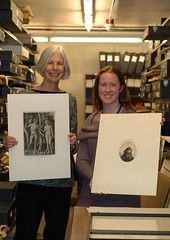 Not lost, just misplaced. That's the word from the Boston Library after it found two
missing prints — a Dürer and Rembrandt worth a combined $630,000.
Not lost, just misplaced. That's the word from the Boston Library after it found two
missing prints — a Dürer and Rembrandt worth a combined $630,000.
But their presumed loss had already set in motion a chain of events, including an FBI criminal probe and the resignation of the library's president.
On Wednesday, a day before they were found, Boston Library President Amy Ryan announced her resignation in the face of mounting criticism over the "missing" prints — one by German Renaissance artist Albrecht Dürer titled "Adam and Eve" valued at about $600,000 and the other, a Rembrandt self-portrait worth an estimated $20,000 to $30,000. Ryan said she would step down effective July 3.
The fact that the prints surfaced just 80 feet from where they were supposed to have been filed, is "a cloud lifted, a burden off our shoulders," Ryan told The Boston Globe. "Everyone is happy."
The prints were found by library conservation officer Lauren Schott in the Copley Square branch during an exhaustive eight-week search of the stacks. Fourteen employees pored through more than half of the 320,000 items located there.
"I was shocked to find the two prints, but it really was just luck of the draw," Schott said in a statement quoted by the Globe. "Any one of the team that's been looking for the Dürer and Rembrandt could have found them."
Melina Schuler, a library spokeswoman, was quoted by the Globe as brushing dismissing the suggestion that someone might have taken the prints and then returned them. She said they were believed to have been misfiled about a year ago in a simple case of "human error."
Even so, Boston Police Commissioner William Evens says the investigation will continue, insisting that "The investigation is not over."
As for Ryan? "It was my decision to resign ... and it's still in place," she said, according to The Boston Herald. "I'm just so happy that the prints have been located."
To read the complete article, see:
Lost
And Found: Missing Rembrandt, Dürer Prints Turn Up At Boston Library
(www.npr.org/sections/thetwo-way/2015/06/05/412236456/lost-and-found-missing-rembrandt-d-rer-prints-turn-up-at-boston-library)
To read the earlier E-Sylum article, see:
CORNERSTONE COINS MISSING FROM BOSTON PUBLIC LIBRARY
(www.coinbooks.org/esylum_v18n22a09.html)
NUMISMATIC AUCTIONS AS EVENTS
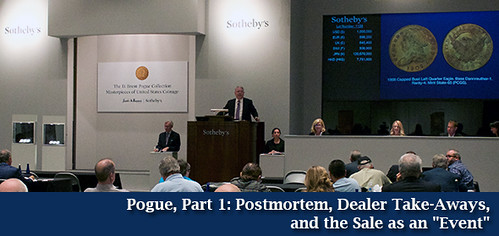
Photo courtesy CoinWeek
Dave Bowers writes:
Thanks for your nice coverage of the Pogue sale in The E-Sylum. In my professional life I have specialized in “events,” rather than just coin auctions. The Garrett, Eliasberg, Norweb, Bass, Childs, and now the Pogue collection sales were far more than sales with a given dollar amount. They have become an indelible part of American numismatic history and tradition. Of course, I have had the backing of the “Dream Team” of experts.
When I close my eyes I think not only of these unique, unequalled sales, but also of the families and people with whom I interacted on them. To the above list of incredible events has to be added the treasure of the S.S. Central America and the book I did for it, one of my fondest memories. We are all lucky to be part of American numismatics. Thank YOU for all you do in the dissemination of information, news, and knowledge
As a preview, Saul Teichman forwarded the below link to a gallery of photos of coins in the next Pogue sale. Thanks! -Editor
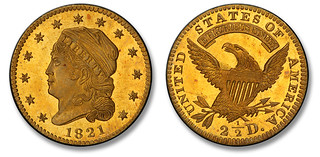
Lot 1048: 1821 Capped Head Left Quarter Eagle
To view coins in the Pogue II sale, see: The D. Brent Pogue Collection, Part II (http://media.stacksbowers.com/poguecollection/pogue-coin-list_2.html)
To read the earlier E-Sylum articles, see:
A CONTEMPORARY ACCOUNT OF THE 1851 ROPER SALE
(www.coinbooks.org/esylum_v13n43a13.html)
FIRST U.S. COIN AUCTION CATALOG: THE 1851 LEWIS ROPER SALE
(www.coinbooks.org/esylum_v15n39a10.html)
THE D. BRENT POGUE COLLECTION: AN APPRECIATION
(www.coinbooks.org/esylum_v18n21a12.html)
A POGUE, PART I POSTMORTEM (www.coinbooks.org/esylum_v18n21a13.html)
HARVEY STACK AND D. BRENT POGUE (www.coinbooks.org/esylum_v18n21a14.html)
NEW YORK TIMES COVERS POGUE SALE (www.coinbooks.org/esylum_v18n22a13.html)
TOKEN, MEDAL AND POLITICAL AUCTION
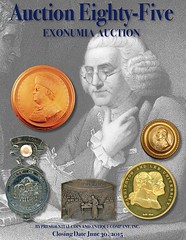
Presidential Coin & Antique Co., Inc.'s Auction Eighty-Five of Tokens, Medals and Political items closes June 30, 2015. Hardcopies $6 - contact Joe Levine at Jlevine968@aol.com or view the catalog online here .
Hard Times Tokens, 19th Century Storecard Tokens, Civil War Tokens, Military & Related, So-Called Dollars, Presidential & Political, World's Fairs & Expositions, U.S. Mint Medals, ANS Medals, Foreign Tokens and Medals, and MORE!
CUT-CANCELLED TREASURY CHECKS 1819-1834
Roger Burdette writes:
While searching correspondence in the archive of the Treasurer of the United States, I came across a box containing hundreds of cut-cancelled Treasury checks issued between 1819 and 1834. I don't know if these are of interest to currency specialists, so here are a couple of photos including the NARA locator information.
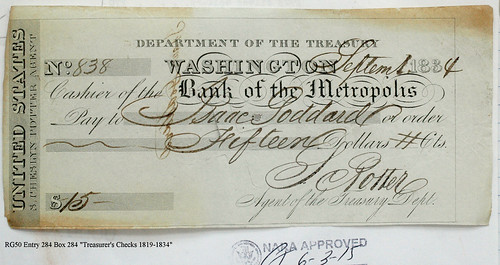
NARA #18340901
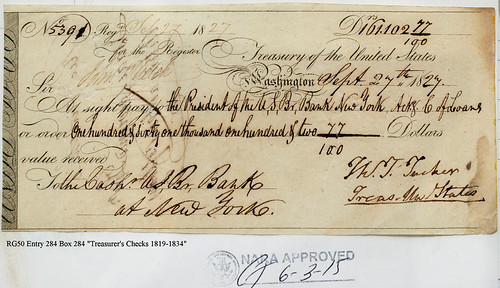
NARA #18270927
SECOND U.S. MINT TREE RELIC
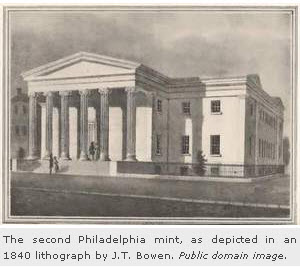
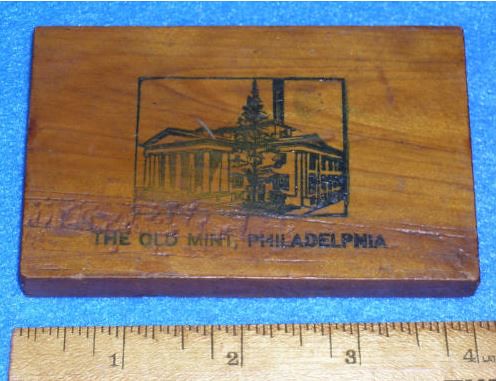
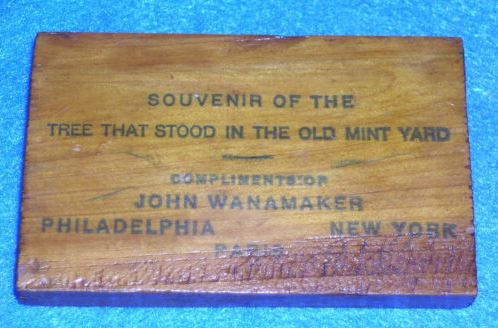
Larry Dziubek writes:
I have been collecting tokens and medals of the John Wanamaker stores and came across this item. I wonder if the winner of this tree relic will get it slabbed?
Joel Orosz writes:
This is a nifty little relic. There are a number of pieces of timber from the first Philadelphia Mint salvaged by Frank H. Stewart when he demolished its remaining structures in 1911, which Len Augsburger and I catalogued in our book, The Secret History of the First U.S. Mint. This appears to be a timber relic from the second Philadelphia Mint, which was razed about 1902. At any rate, it is clearly an image of the second Mint burned into the timber. A "compete set" of timber relics would comprise one from the first and one from the second Mints, since the third Mint is still in use as a community college, and the fourth Mint is still making our coinage.
Len Augsburger writes:
Obviously it is from the 2nd Mint, which was demolished c. 1902. At the time, few Philadelphians realized the real “Old Mint” was the first Mint site located on 7th Street. Frank H. Stewart made quite a few relic pieces from 1st Mint timber, but apparently kept no inventory. Of course, half the fun is trying to reconstruct the list, which can be found in Secret History of the First U.S. Mint.
To view the complete eBay description, see:
Antique
PHILADELPHIA PA * THE OLD MINT WOODEN RELIC Compliments JOHN WANAMAKER
(www.ebay.com/itm/Antique-PHILADELPHIA-PA-THE-OLD-MINT-WOODEN-RELIC-Compliments-JOHN-WANAMAKER-/381271246250)
MORE ON THE COREY'S OINTMENT COUNTERSTAMP
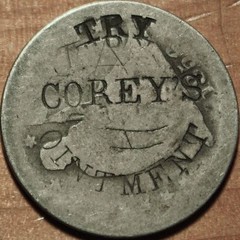 Wish I had a nickel for every time I'd heard a collector opine the following: "If only
this coin could talk!" Well, counterstamped coins often do tell us quite a bit about their travels, their uses, their handlers and
more. Yet, there remain those that seem stubbornly resistant to attempts at attribution. Such has long been the case with the "TRY
COREY'S OINTMENT" issue on this Liberty Seated Quarter.
Wish I had a nickel for every time I'd heard a collector opine the following: "If only
this coin could talk!" Well, counterstamped coins often do tell us quite a bit about their travels, their uses, their handlers and
more. Yet, there remain those that seem stubbornly resistant to attempts at attribution. Such has long been the case with the "TRY
COREY'S OINTMENT" issue on this Liberty Seated Quarter.
Previous E-Sylum articles have speculated about the issuer of this counterstamp, but with the aid of the internet, I've stumbled upon a most likely prospect. Let's look at the evidence ...
Dr. Medad Smith Corey (1827-1908) was born on Long Island, attended medical school in Buffalo, graduating in 1861, settled in Chautauqua County, NY and commenced to practice medicine. On October 9, 1883, Dr. Medad S. Corey, then of Hamlet, NY, was granted patent # 3,575 for "The Eureka Pile Ointment."
Such are the facts. I'm now in the process of learning more about Medad. It seems that he owned a small country store and maintained a garden out back, wherein he grew herbs and produce. He was a member of the Odd Fellows. He conducted Prohibitionist meetings and ran unsuccessfully for a seat in the state assembly on that ticket. He apparently sold his patent to a Cincinnati company that was still marketing his Eureka Pile Ointment as late as 1913. He retired in 1892 and sold life insurance in his later years. He traveled extensively and was held in high esteem by all newspaper accounts.
With regard to the Corey counterstamp, I note a striking similarity between the Corey's Ointment issue and that of the Sage's Candy Coin issue. The latter is suspected of emanating from Buffalo, NY, wherein Dr. Corey earned his medical degree. Both issues appear to have circulated in the 1870-80's.
Summarily, I'd submit that Dr. Medad Smith Corey, an enterprising man with a patented ointment to his credit, is the most likely issuer of this counterstamp issue. The stamped coins may have been used as a promotion and to establish credibility, prior to his seeking the patent. Oftentimes, the attribution of counterstamps admittedly remains tenuous at best. Hopefully, this path may lead to more absolute evidence.
Internet Resources:
Gravesite
Medical Degree
Patent Listing
To read the earlier E-Sylum article, see:
NEW INFORMATION ON THE COREY'S OINTMENT COUNTERSTAMP
(www.coinbooks.org/esylum_v14n22a16.html)
NEW RESEARCH ON THE EVERMAN COUNTERSTAMP
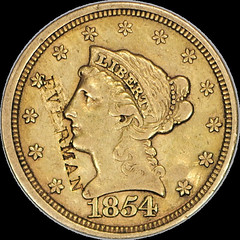
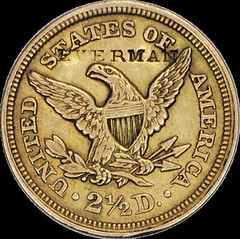
My article in this month's issue of The Numismatist was on a mysterious counterstamp that has shown up on ten coins so far, including a half dozen gold coins, a rare undertype as a class. The coins all bear the small and quite precisely made EVERMAN mark and with only one exception are all dated in the 1850s.
The counterstamps have been traditionally attributed to California primarily on the basis of one coin: an 1852 Augustus Humbert $50 octagonal "slug," an astonishing undertype for any counterstamp. However, the person to whom this mark was assigned, a WIlliam Everman, was actually a miner who got caught up in a murder over a stolen watch and was hanged in 1853. Considering that several of the coins are dated 1854, 1855, and 1856, it certainly couldn't be him. However, there is a better candidate: a silversmith in Huntingdon, Tennessee by the name of Lewis Everman who worked in the 1850s.
What's interesting is that after the article went to press, I found an 1866 business directory listing for Everman & Spence, jewelers in Jackson, Tennessee, one county over, so it's possible Everman moved to a bigger town and partnered up. I am continuing to dig into Everman and hope that perhaps someday a well-documented piece of flatware with that mark can be definitively tied to the counterstamp. Research is never-ending and it's what I love about numismatics.
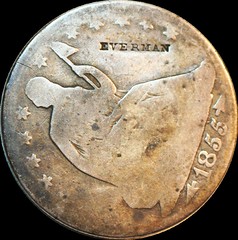
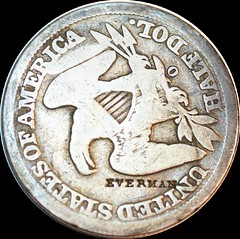
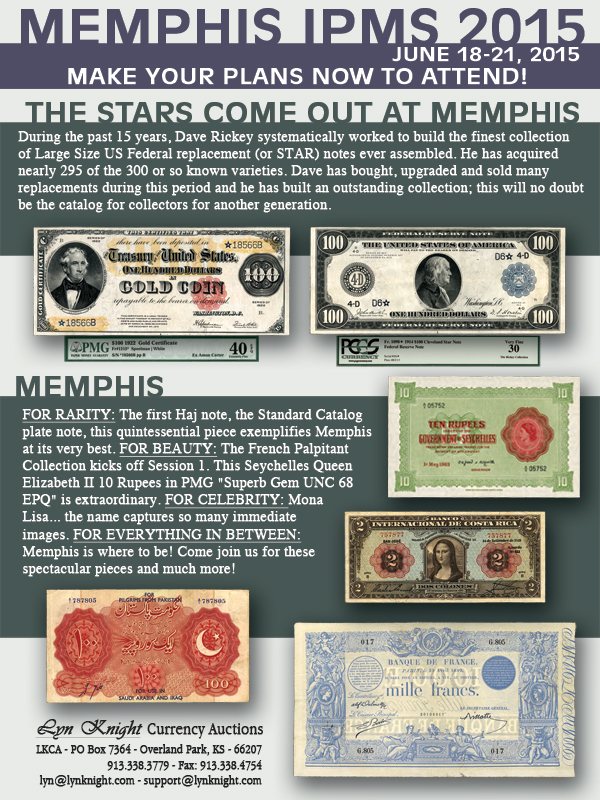
MAKING MONEY WITH JEFFERSON NICKELS
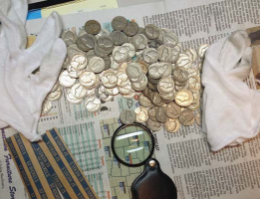 If
someone told you that you could make a 20 percent return with absolutely no risk of losing money, you’d probably think you were talking to
a would-be Bernie Madoff.
If
someone told you that you could make a 20 percent return with absolutely no risk of losing money, you’d probably think you were talking to
a would-be Bernie Madoff.
Dealer Wayne Herndon in Virginia is one buyer willing to pay six cents for pre-1960 Jefferson nickels. Certain key dates and the silver examples net a higher return, of course. But Herndon’s offer stands for even the most common years and Mint marks.
I first learned of Herndon’s offer through Wayne Homren, editor of E-Sylum. In the March 15, 2015, edition of the weekly newsletter, Homren recounted a story heard at a recent gathering of collectors in the Washington, D.C., area.
Herndon explained to Coin World his offer to pay 20 percent above face value for these relatively common coins.
“I’m a dealer, and like most dealers I am constantly offered collections, accumulations, etc. ... Like bags of wheat cents, there is a market for bags of pre-1960 Jefferson Nickels.”
Herndon sorts the coins into bins. After a bin gets full, he’ll run coins through a counter and assemble bags of 4,000 coins ($200 face value).
“Most of this stuff is wholesaled in my case and I have customers who from time to time will ask for bags of pre-1960 [Jeffersons],” he said.
He doesn’t search them for varieties or even date/mintmark combinations that are better, as that is rarely worth the investment in time.
The E-Sylum discussion sparked a memory for me. When I was in high school and college, I worked at a national pharmacy chain found at the corner of happy and healthy.
As a cashier and photo clerk, I soon gained confidence of managers to search through multiple cash drawers daily to buy any coins or paper money of interest.
At some point during my employment, I began harvesting pre-1960 5-cent coins, though my memory is foggy as to the exact reason I fixed on that date for the search. My reasoning then was, these are 35+ years old, and if I wait another few decades, they’ll be even older. The investment cost was certainly the right price — I could always cash them in and not lose any money.
I amassed thousands of these coins, many of which came with me to Ohio when I started at Coin World full-time in early 2004.
The discussion on E-Sylum, and an already fertile desire to winnow down my holdings, sent me searching into the collecting closet, where I found the pile.
To read the complete article, see:
MAKING MONEY WITH JEFFERSON NICKELS
(www.coinworld.com/voices/jeff-starck/2015/05/making_money_withje.html)
To read the earlier E-Sylum article, see:
WAYNE'S NUMISMATIC DIARY: APRIL 19, 2015 : The Big Nickel Transaction
(www.coinbooks.org/esylum_v18n16a24.html)
MORE ON OBVERSES AND REVERSES
Steve Bishop writes:
Regarding the term "obverse", typically the obverse depicts the head (such as a monarch) or the principal design (such as the object of a commemoration). It often carries the date as well. But the obverse being "heads" is not the rule. Civil war storecards, for example, designate the merchant's descriptive information, with the reverse being whatever ornamental device is desired. The listing of reverse dies in the Fuld reference on storecards pictures numerous liberty heads, indian heads, and portraits of famous people like George Washington.
Ed Hohertz writes:
Islamic coins present their own difficulties with determining the obverse side. For the medieval coins, there are usually only legends on both sides. The attached article gives some insight into those problems.
Summary p190 second paragraph:
'The only solution is for scholars to define obverse and reverse in terms of the priorities they consider most important and then
be consistent in their own work.'
Stephen Album in his 'Checklist of Islamic Coins' (3rd ed.) takes about half a page (p15) defining the obverse of a coin.
To read the earlier E-Sylum article, see:
VOCABULARY WORD: OBVERSE (www.coinbooks.org/esylum_v18n22a07.html)
BALTIMORE'S WASHINGTON MONUMENT TIME CAPSULE OPENED
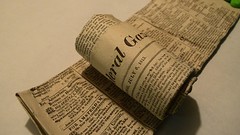 Early pictures of the U.S. Declaration of Independence and many artifacts commemorating the centennial
of the "Star-Spangled Banner," Baltimore's Washington Monument and other key aspects of American history were revealed
Tuesday.
Early pictures of the U.S. Declaration of Independence and many artifacts commemorating the centennial
of the "Star-Spangled Banner," Baltimore's Washington Monument and other key aspects of American history were revealed
Tuesday.
The 1915 Centennial Time Capsule was one of two time capsules discovered during the renovation of Baltimore's Washington Monument, the first to honor George Washington.
The monument's original 1815 cornerstone was found in February with an inner lid carved with names of the monument's original masons and stone cutters. There were also three glass jars stuffed with newspapers and wrapped bundles.
Each jar appears to tell a story.
One jar contained Washington's likeness, a copy of his presidential farewell address, 10 U.S. coins, a medal of Washington and a medal honoring the Duke of Wellington's military campaigns in the Spanish Peninsular Wars.
A second jar contained a 1812 copy of the Bible.
The third jar had July 5 and July 6, 1815, copies of the Federal Gazette. The July 6 paper has a story about the cornerstone being laid.
On top of the jars was a copy of the Declaration of Independence, reprinted in the Federal Gazette on July 3, 1815.
Another party is scheduled for July 4, the bicentennial of the laying of the monument's cornerstone. After the monument is rededicated that day, it will be opened again to the public.
The Maryland Historical Society will also display some of the items starting on July 4.
To read the complete article, see:
History revealed: Baltimore time capsule
opened (www.wcvb.com/money/travel/history-revealed-baltimore-time-capsule-opened/33365462)
To read the earlier E-Sylum article, see:
1815 TIME CAPSULE AT BALTIMORE'S WASHINGTON MONUMENT
(www.coinbooks.org/esylum_v18n08a12.html)
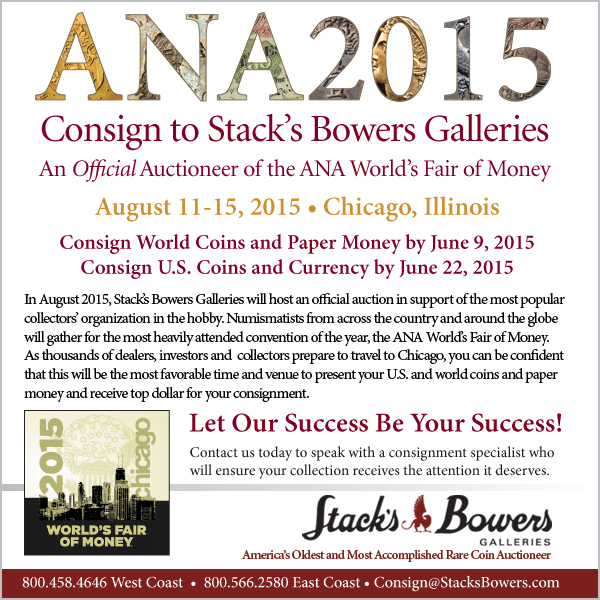
SELECTIONS FROM NUMISMATIC AUCTIONS SALE 57
Chalmers Shilling, Annapolis 1783
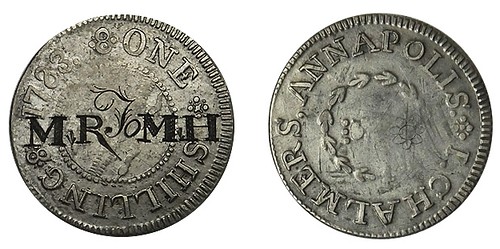
Chalmers Shilling, Annapolis 1783. Long worm variety. Details nearly Fine by wear, “MR to MH” ornately engraved obverse off axis and a very faint flower scribed at center reverse, unusual. A rare love token indeed.
1856 Flying Eagle Cent
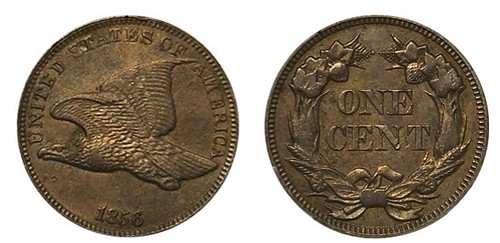
1856. Key date. Early ANACS paper certificate as AU50/50, 11- 27-85. This example appears to have been struck on a mildly porous planchet with a cpl minor flan flaws, a few tiny rns yet very sharp with hints of luster remaining.
1865 Three Cent Nickel Proof
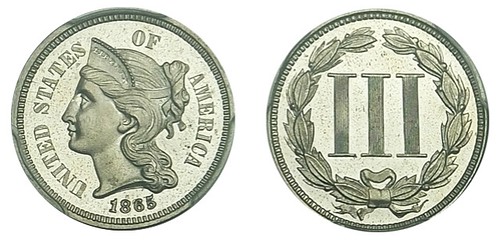
1865. PCGS PR63 CAM. The sleeper under-appreciated Key to the Proof series and low mintage first year Proof issue.
1875-CC Twenty Cent Piece
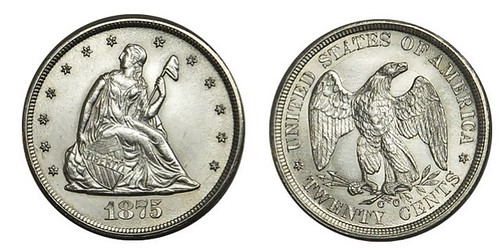
1875-CC. Lightly hairlined lustrous Choice AU-Unc, initial appearance of BU until closer inspection. A nice example of this scarce Carson City Mint issue.
1862 Dollar
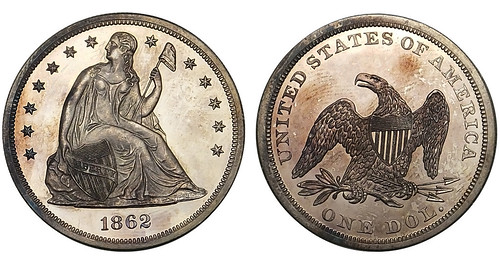
1862. Brilliant Proof, light hairlines and some faint contact keep this from Choice. Nicer appearance than grade suggests with strong mirrors and splashes of gold to violet toning. Scarce Civil War issue.
1834 Half Eagle
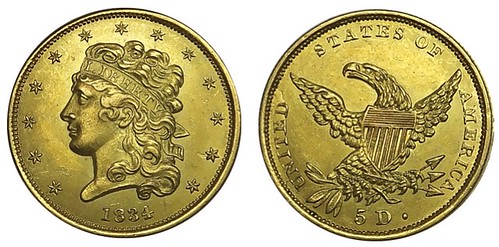
1834. Classic Head, Plain 4 variety. Outstanding AU, a few tiny mks, reverse looks Unc. Great type coin.
1850 Liberty Cap Three Cents Silver
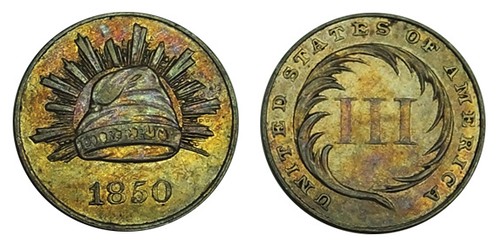
Liberty Cap Three Cents Silver, 1850. J-125. Colorful Proof AU, lt hdlg primarily on the reverse not detracting. Pleasing and appealing.
1987 Pattern Half Eagle Three Coin Set

1987 Pattern Half Eagle Three Coin Set in Gold Plate (Mintage: one-unique), Silver (Mintage: 55) and Tungsten (Mintage: 90). Bicentennial of the United States Constitution. Designed by Fred Zinkann. All 22mm. Matte Unc. 3 coins.
Fred Zinkann made several patterns as proposals to the US Mint for 1987 Constitution commems. These were produced in silver, gold, hafnium, and tungstun. These patterns are covered in Pollock's US Patterns book, available through Bowers and Merena. Several sets were put together in silver and tungstun - I have not seen any available for quite some time.
To read the complete article, see:
Who is/was Fred Zinkann?
(www.foundcollection.com/1_ab0332424dc0ec24_1.htm)
For more information on the auction sale, see
www.numismaticauctionsllc.com
SELECTED CIVIL WAR TOKENS FROM STEVE HAYDEN
1863 Army & Navy Patriotic Civil War Token
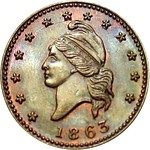
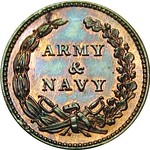
Civil War Token Fuld 11/298 a R1 Very Nice Uncirculated with 10% Red mainly on reverse, attractive toning and nice cartwheel luster. 1863 Army & Navy with crossed swords
To view the complete lot description, see:
1863 Army & Navy Patriotic Civil War Token
(www.ebay.com/itm/1863-Army-Navy-Patriotic-Civil-War-Token-/221780243540)
1863 Union Hunting Dogs Patriotic Civil War Token
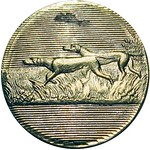
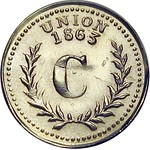
Civil War Token Fuld 184/427 j R8 NGC UNC Details, improperly cleaned. Very rare and popular die. The obverse is the famous Hunting Dogs die, though it might just as well be known as the Running Dogs or even Pointing Dogs. Either way it is a fascinating die so much so that the late Bret Palser made it literally his calling card
To view the complete lot description, see:
1863 Union Hunting Dogs Patriotic
Civil War Token R8 NGC (www.ebay.com/itm/1863-Union-Hunting-Dogs-Patriotic-Civil-War-Token-R8-NGC-/221785647865)
1863 New York City Civil War Token: Coin Token Press
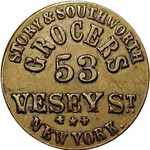
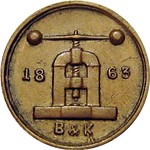
Civil War token Fuld NY630BV-1a R3 EF+. Story & Southworth Grocers 53 Vesey Street New York 1863. With picture of a coin or token press on the reverse.
To view the complete lot description, see:
1863 New York
City Civil War Token Story & Southworth Grocers Coin Token Press
(www.ebay.com/itm/1863-New-York-City-Civil-War-Token-Story-Southworth-Grocers-Coin-Token-Press-/381281732512)
To view all of Steve's current Civil War Token lots, see:
Civil War Tokens
(http://stores.ebay.com/stevehayden/Civil-War-Tokens-/_i.html?_fsub=1079906014)
HEEREN FAMILY BACKGROUND ON THE COLUMBIA SHIELD
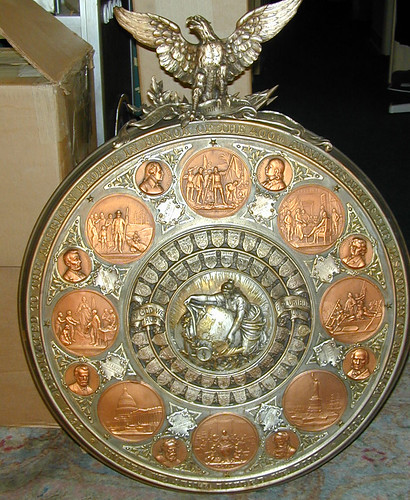
The following information was compiled by my Great-Uncle Alfred Demmler (better known as Uncle Peter). Uncle Pete died in 1989 and the shield was given by his wife to one of her relatives. Unfortunately I don't know who this person is. Another family member, Great-Aunt Evelyn Demmler, married to great-Uncle William Demmler was also in possession of one of the shields. It disappeared after her death and we suspect that it was sold with her estate.
Two other shields exist in addition to the one given to President Cleveland. One belongs to the Klindworth family (I don't know them. The 4th one is in my possession. It belonged to my great uncle Oscar Demmler who passed it to my Dad. When my parents died in 2005, I gained possession of what the family refers to as the Demmler shield.
The following was compiled by my Great-Uncle Pete:
"A small number of these shields were imported from Germany by Heeren Brothers Company, (a jewelry store then located at the corner of Penn Avenue and 8th street in downtown Pittsburgh. The motive behind the manufacture of these shields was revealed by the outermost peripheral inscription "dedicated to the American people in honor of the 400th anniversary of the discovery of America,,1892..' Following the actual discovery date...1492...the inscription continues "United we stand.. Divided we fall."
"My maternal grandfather, Fred Mayer (born Sept 17, 1832 in Lauffen on the Neckar River, wurst berg, Germany) created most of the designs for the medallions, shields and plaques, as well as the large eagle at the top of the shield, above another inscription "westward Ho the star of empire makes its way". He transmitted these designs to a metal manufacturing company operated by two of his brothers in Stuttgart, Germany. They produced these shields made of pewter, bronze, copper (filigree), and sheet iron."
"There are 8 large medallions showing various buildings and events in the first 2 or 3 centuries of American history. There is another ring of 8 small medallions depicting four presidents, Washington, Jefferson, Lincoln, Grant, and also four other notable figures, Clay, Morse, Longfellow, and Franklin."
There is some additional information which I have not included because it is obvious by looking at the shield. I should add that in family lore there is no mention of a shield being given to President Cleveland. It just might be that Uncle Pete forgot or wasn't aware. The Demmlers were known to live well in their 90's and many suffered from dementia.
Fred Meyers great grandson Frederick Demmler, was a very well-known painter who was killed during the last week of WWI. A book was written about him and he has a painting hanging in the Carnegie. My Great-great grandfather Fred Mayer remained a sculptor for the remainder of his life. At some point he immigrated to Pittsburgh and continued to work mostly in stone. There is a church in Pittsburgh that has multiple stone statues that he created. We also have a large stone lion sitting in front of my parents’ house.
I hope that this information has proven to be helpful.
To read the earlier E-Sylum articles, see:
QUERY: THE HEEREN BROTHERS COLUMBIA SHIELD
(www.coinbooks.org/esylum_v15n36a10.html)
MORE ON THE COLUMBIA SHIELD (www.coinbooks.org/esylum_v15n37a12.html)
THE BOOK BAZARRE
QUERY: WERE TOKENS USED IN THE KALAUPAPA LEPER COLONY?
Not so long ago, people in Hawaii who were diagnosed with leprosy were exiled to an isolated peninsula attached to one of the tiniest and least-populated islands. Details on the history of the colony—known as Kalaupapa—for leprosy patients are murky: Fewer than 1,000 of the tombstones that span across the village’s various cemeteries are marked, many of them having succumbed to weather damage or invasive vegetation. A few have been nearly devoured by trees. But records suggest that at least 8,000 individuals were forcibly removed from their families and relocated to Kalaupapa over a century starting in the 1860s. Almost all of them were Native Hawaiian.
Sixteen of those patients, ages 73 to 92, are still alive. They include six who remain in Kalaupapa voluntarily as full-time residents, even though the quarantine was lifted in 1969 —a decade after Hawaii became a state and more than two decades after drugs were developed to treat leprosy, today known as Hansen’s disease. The experience of being exiled was traumatic, as was the heartbreak of abandonment, for both the patients themselves and their family members. Kalaupapa is secluded by towering, treacherous sea cliffs from the rest of Molokai—an island with zero traffic lights that takes pride in its rural seclusion —and accessing it to this day remains difficult. Tourists typically arrive via mule .
To read the complete article, see:
When the Last Patient Dies
(www.msn.com/en-us/news/weekendreads/when-the-last-patient-dies/ar-BBkiwUt)
1 Peso Culion Leper Colony token
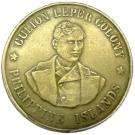
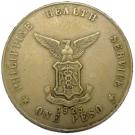
To read the complete web page, see:
http://en.numista.com/catalogue/pieces21631.html
Hald Centavo Culion Leper Colony token
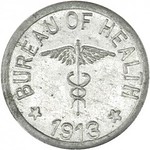
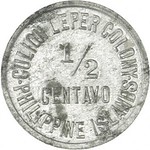
To read the complete web page, see:
Special Tokens Issued to Serve as
Currency in Culion Leper Colony (www.worthpoint.com/blog-entry/special-tokens-issued-serve-currency-culion-leper-colony)
I love handing examples of these coins (not in holders) to people. They will look them over front and back, they seem to find them somewhat interesting. Then comes the question "Where is it from?" "Leper colony." The look on their face is priceless and they can't hand them back fast enough.
One of my friendly dealers keeps a small pile of the Columbia 50 centavos lazareto coins on his table. It’s an attractive nuisance. Inevitably, someone will reach across the table & start knocking them around asking what they are. When they learn that they are touching Leper colony coinage, they stop fingering the coins pretty quickly. After some small talk, they usually make a beeline walk to the men’s room to wash their hands.
To read the complete CoinTalk discussion, see https://www.cointalk.com/threads/leprosy-colony-coins-data-previous-thread-links.203823/)
DIX NOONAN WEBB SEPTEMBER 2015 AUCTION SALES
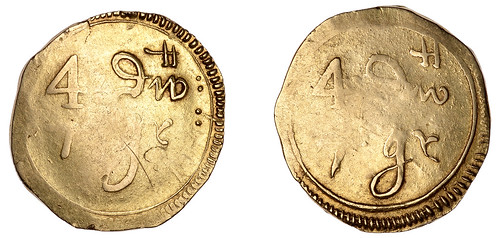
An Ormonde Money gold Pistole from the Theo Bullmore Collection
Three important collections are to be auctioned during a three-day ‘coins festival’ at Dix Noonan Webb, the international coins and medals specialists, in London from 15-17 September 2015. Collections assembled by Harrington Manville, Theo Bullmore and Paul Cattermole will, together with coins and commemorative medals from other vendors, total more than 2,000 lots providing the market with an extraordinary range of pieces, including many rarities.
“This will be a very special few days with collections put together by three men with different specialist interests but the same discerning eye becoming available to the market,” says Christopher Webb, head of the coins department at Dix Noonan Webb. “We are proud to be holding this exceptional series of auctions.”
Harrington Manville, whose Collection of Scottish Silver Coins 1660-1800 will be auctioned by Dix Noonan Webb, was one of the world’s most renowned experts on British numismatics. The retired American diplomat, who died aged 85 in February this year, was the author of the magisterial Encyclopaedia of British Numismatics, which was published in six parts between 1986 and 2014.
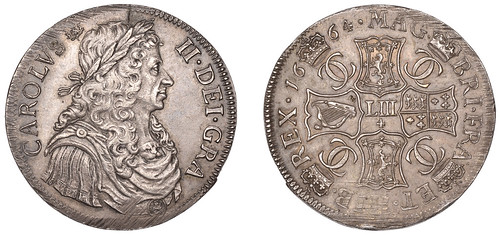
A very rare 1664 Scottish 4 Merks from the Manville Collection
As a collector, researcher and author, Manville, always known as Harry, was a significant contributor to knowledge about British numismatics over almost half a century. One of the rarest pieces in his Scottish collection is a Charles II first coinage four Merks dating from 1664. This example is almost certainly the finest specimen of the Scottish silver coin available to the market and is expected to fetch £6,000 to £8,000. It was once in the famous Bridgewater House Collection begun by John Egerton, the second Earl of Bridgewater, in the 17th century and largely completed by 1740. The Bridgewater House story shows us that 17th and 18th century coins were being acquired contemporaneously by collectors during this period. The collection was later placed in the British Museum for safe keeping, where it remained from about 1850-1900. A rare William and Mary Sixty Shillings minted in Scotland in 1691 from the Manville Collection is estimated at £2,000 to £3,000.
More superb pieces will be auctioned from the Theo Bullmore Collection of Irish Coins, Charles I and the Great Rebellion. Bullmore is a British chartered accountant who rose to become managing partner in the global financial services company KPMG. He now acts as a consultant to the company and, in addition to being a keen sportsman, is a passionate coins collector, an interest which he inherited from his collector father.
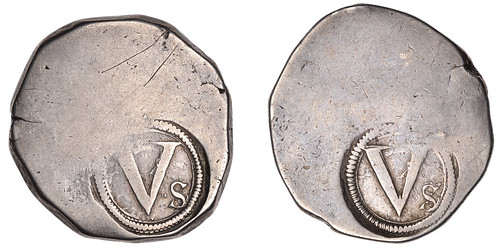
Bullmore Dublin Money Crown
The highlight of his Irish coins collection is an Ormonde Money gold Pistole dating from 1646-47 which is expected to sell for £80,000 to £100,000. The Duke of Ormonde, Lord Lieutenant of Ireland and the Royalist commander in Dublin during the Civil War, issued instructions that gold was to be melted down and converted into ‘pledges’ to alleviate the currency shortage suffered by the King’s garrison in Dublin in 1646. This currency of necessity represents the only gold coinage of Ireland and the example to be auctioned from the Bullmore Collection is believed to be one of only two available to the market. Other important coins from the collection include an extremely rare Confederate Catholics ‘Rebel Money’ Halfcrown, estimated at £10,000 to £12,000, and a very rare Charles I Dublin Money Crown, expected to fetch £6,000 to £8,000.
The Paul Cattermole Collection of British Sixpences will also be auctioned during this three-day period. Cattermole, who worked for an insurance company in Surrey until he retired in 2008, has collected coins since the 1960s and more recently specialised in halfpence and sixpences. He has reluctantly decided to sell the latter from his collection to finance continuing to buy halfpence. Among the rarities to be auctioned at Dix Noonan Webb will be a 1555 sixpence from the joint reign of Philip and Mary, estimated at £1,200 to £1,500, and an Elizabeth I 1561 sixpence with a superb portrait of the monarch, which should fetch £500 to £700.
Dix Noonan Webb will also hold an auction of Coins and Commemorative Medals from other vendors. Among the many fine pieces to be offered for sale will be an exceptionally rare gold medal struck in 1750 promoting the Legitimacy of the Jacobite Succession and depicting Prince Charles Edward Stuart, who had launched the unsuccessful Jacobite Rebellion of 1745, estimated at £5,000 to £7,000. A very rare Victoria Pattern Double-Florin from 1868 is predicted to fetch £5,000 to £6,000.
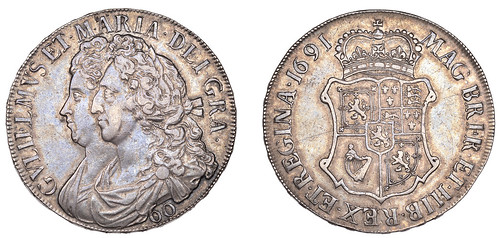
1691 William and Mary Sixty Shillings minted in Scotland
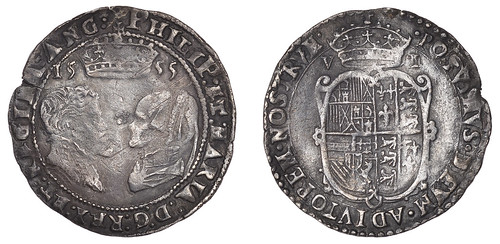
Philip and Mary 1555 sixpence
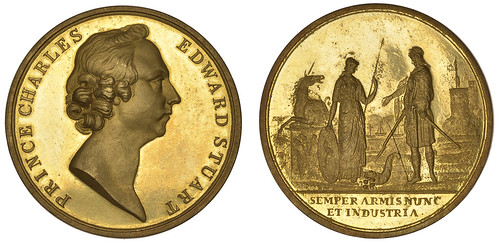
1750 gold medal promoting the Legitimacy of the Jacobite Succession
For more information, visit the company's web site at:
www.dnw.co.uk
THE BOOK BAZARRE
BALDWIN'S OFFERS WATERLOO MEDALS
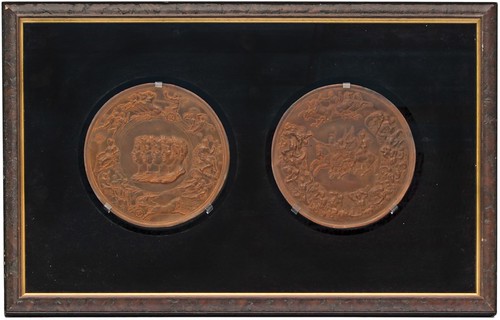
Waterloo Medal, 1815, Copper Electrotype Medal, by Benedetto Pistrucci.
A Wonderful and Complete Collection of the Gutta Percha, Electrotypes and Electrotype Mould of Benedetto Pistrucci’s magnificent Waterloo Medal.
In 1816 Pistrucci was asked to submit designs for the medal, which were to be struck in gold for allied sovereigns, their ministers and generals. Although he produced preliminary designs quickly, work on the medal itself proceeded slowly then lapsed due to his rivalry with others in the mint, and it was not until 1844, after many years of bitter negotiations over salary and status, that the work resumed.
The dies were only completed in 1849 by which time the four allied sovereigns had died. Difficulties in producing such massive dies meant that they were never hardened and the only medals produced were extremely rare gutta percha impressions and electrotypes. The wax model for the medal is in the Mint Museum in Rome and the dies are in the Royal Mint Museum. It remains one of the most iconic commemorative medals in the British series.
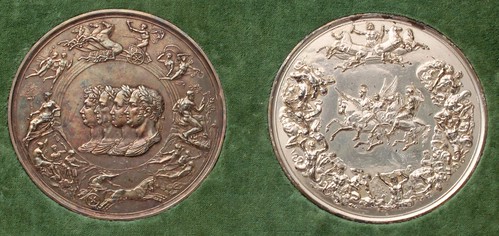
1815, Silver-plated Copper Electrotype Waterloo Medal,
To read the complete catalog, see:
www.sixbid.com/browse.html?auction=2029
SELECTIONS FROM PRESIDENTIAL AUCTION #85
Lot 8: John L. Chapman Token
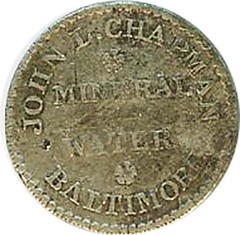
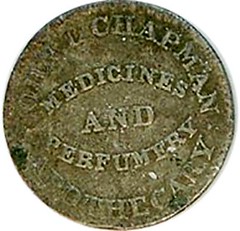
LOW UNLISTED. JOHN L. CHAPMAN, BALTIMORE, MD. Miller MD 30; Schenkman 60 C86. 16mm, German Silver. F/VF with fields consistent with this worn grade. Obverse; JOHN L. CHAPMAN BALTIMORE around MINERAL/ WATER. Reverse: JOHN L. CHAPMAN APOTHECARY around MEDICINES/ AND/ PERFUMERY.
Rulau lists three of Chapman’s tiny German Silver tokens as belonging to the Hard Times period. He further notes that “There are two other tokens and Chapman (Miller MD. 30 & 31) which probably are later than the Hard Times Period.” However, he cites no reason for this opinion and even neglects to list these two tokens in his 1845-60 Section. While we can’t disagree with Rulau’s reasoning (because there is none!) our inclination is to believe that if his three listed german silver tokens properly belong in the Hard Times period, then this one does too! ($750+)
Lot 262: Bronze Plaque Of President James A. Garfield
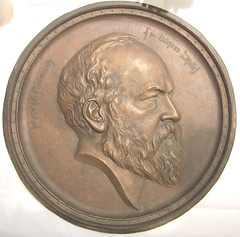
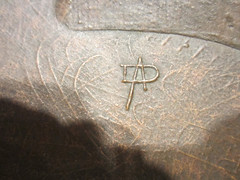
BRONZE PLAQUE OF PRESIDENT JAMES A. GARFIELD, ND. 17” Cast Bronze. Signed below the truncation of the bust with the monogram DA. About Uncirculated. A handsome bearded bust of Garfield faces right. The legend is inscribed in an unusually styled lettering which reads: TWENTIETH PRESIDENT OF THE UNITED STATES.
Our consignor thought that the monogrammed signature was that of Adam Pietz. Although a cursory glance at the monogram makes it look like Pietz’s AP signature, closer examination reveals that it is clearly not. We have been unable to determine the identity of the artist. He is, however, a sculptor of obvious talent.
Lot 288: Grover Cleveland Satirical Inaugural Token
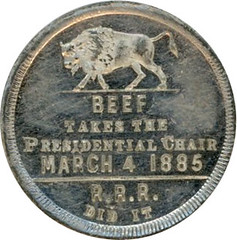
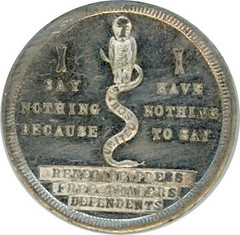
GROVER CLEVELAND SATIRICAL INAUGURAL TOKEN, 1885. GC 1884-11. 28m. White Metal. Bright Uncirculated. A bison is at obverse top. Between two horizontal lines is inscribed: BEEF/ TAKES THE / PRESIDENTIAL CHAIR/ MARCH 4TH, 1885. BELOW: R.R.R./ DID IT. At the center of the reverse is a figure with the body of a bird and the head of a man, perched upon a snake inscribed, UNITED SOUTH. To either side is the legend: I SAY NOTHING BECAUSE/ I HAVE NOTHING TO SAY. Inscribed on a ribbon below is; RENEGADE PRESS/ FREE TRADERS/ DEPENDENTS.
This is one of this writer’s favorite political tokens. The bison refers to Buffalo, NY where the beefy President Cleveland was at one time the mayor. “R.R.R.” refers to Blaine’s unfortunate utterance of “Rum, Romanism and Rebellion”. The face of the harpy on the reverse is meant to be Blaine’s. The design has given us a male harpy - Virgil and Hesiod have given us only females. In Greek mythology, Harpies were vultures with the head and breasts of a woman. They were very fierce and loathsome, living in an atmosphere of filth and stench and contaminating everything which they touched! A Proof-like Unc. example brought $373.75 in our 2003 Auction Eighty Three.
Lot 334: Panama Pacific Exposition Official Award Medal
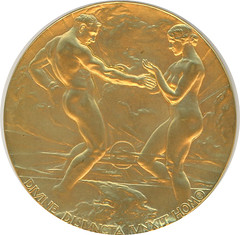
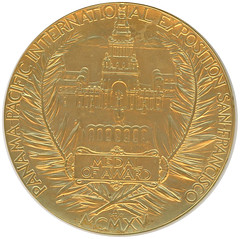
PANAMA PACIFIC EXPOSITION OFFICIAL AWARD MEDAL, 1915. Baxter 114; Marqusee 150. 70.4mm.
Gold plated Bronze. John Flanagan, Sc. (U.S. Mint). Gem Uncirculated – as nice as we have seen. The obverse bears a pair of nude figures representing the uniting of the Atlantic and Pacific Oceans. The reverse features a view of the Jewell Tower, the architectural centerpiece of the exposition, surrounded by an expo legend. MEDAL OF AWARD inscribed within a cartouche below the building. The medal is housed in its uninscribed round black fabric case of issue
The U.S. Mint struck only 2,000 of these medals in bronze - far fewer than the numbers struck for the official award medals for the Columbian and the 1904 Saint Louis Expositions.
In a letter to exhibitors from the Secretary of the PPIE Award System, it was stated, “Following the custom of all expositions, and as already explained to exhibitors, the Medal of Award in each case is made of Bronze. By virtue of this fact, exhibitors are expected to have their medals PLATED, at their own expense. If the award be that of Grand Prize, Medal of Honor or Gold Medal, have the medal corresponding to the Diploma GOLD plated. If the award be Silver Medal, have the medal SILVER plated. If the award by Bronze Medal, LEAVE THE MEDAL INTACT.”
Lot 336: U.S. Sesquicentennial Official Award Medal
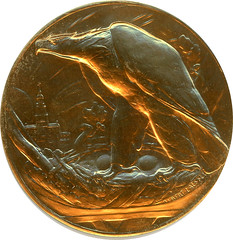

UNITED STATES SESQUICENTENNIAL OFFICIAL AWARD MEDAL, 1926. Marqusee 234. 76.5mm. Gilt Bronze. Albert Laessle, Sc. (Bailey, Banks & Biddle Co.). Gem Uncirculated - as nice as we have seen! The obverse portrays a young mother bald eagle who guards the home nest of peace and prosperity. Within the nest are two eggs which are the symbol of continuing productivity. In the background, Independence Hall is outlines against the rising sun. The reverse legend reads: SESQUICENTENNIAL- INTERNATIONAL - EXPOSITION - PHILADELPHIA - 1776 - 1926 around a wreath enclosing the inscription: MEDAL OF AWARD, above a radiant sun.
Lot 358: State Department Medal
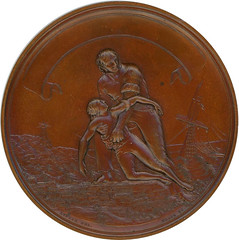
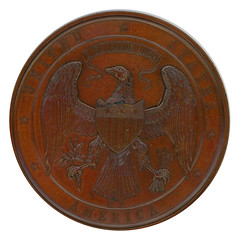
STATE DEPARTMENT MEDAL. LS-1. 66.8mm. Copper, bronzed.. Salathiel Ellis, Sc. Designed by Emmanuel Leutze. Nice Uncirculated with a handsome mahogany finish. Obverse with the arms of the United States. The reverse depicts a rescue scene along a shore. Above is a blank scroll for engraving the name of the recipient. This piece is unawarded. Note that the 71mm size given by Julian is in error. John Kraljevich estimates that 64 unawarded specimens were struck in bronze between 1860 and 1904.
For more informtion, see:
http://www.maineantiquedigest.com/custom/presidential.htm
QUERY: WHAT DOES THIS MEDALET'S INSCRIPTION MEAN?
With close to a million objects in the American Numismatic Society’s collections, the curatorial team occasionally comes across items that are mysteries to us. This series will feature some of these objects in the hopes that the collective wisdom of our readers can help us to identify and learn more about them.
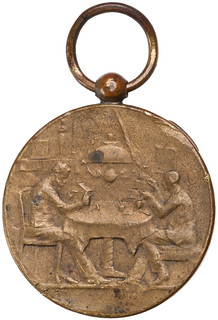

This bronze medalet appears to be a membership or attendance medal for some unknown society. It is not exactly clear to us what activity the gentlemen on the obverse are engaged in, but they appear to be building a model ship. It measures 25.5 mm in diameter and the reverse has the legend: C. / O. O. / O’ HOUT / MEI 1916
To read the complete article, see:
MYSTERIES FROM THE VAULT: MEDALET
(www.anspocketchange.org/mysteries-from-the-vault-medalet/)

SOME RECENT COIN DESIGNS: JUNE 7, 2015
Cook Island Five Dollars
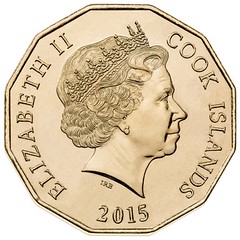
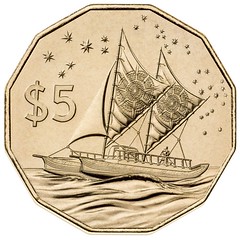
2015 Lithuania 5 Euro coin on Literature
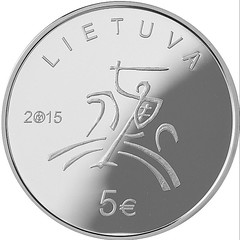
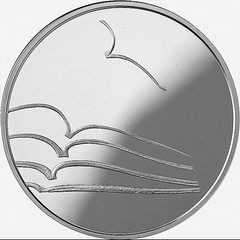
2015 Greece 10 Euro on Aristophanes
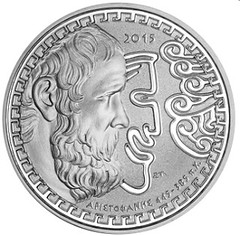
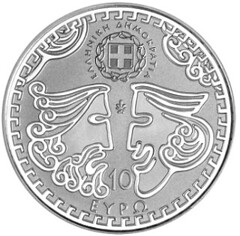
QUERY: AUSTRALASIAN BANK CHEQUE INFORMATION SOUGHT
Reader Gerry Peacock's communication comes all the way from Brisbane, Queensland, in Australia. He writes:
I was wondering if you’ve ever done an article / feature on Early Australian & New Zealand Cheques ( or Checks I think you call them in USA ! ) I'm referring to company & personal banking cheques of the earlier period 1850-1910 which, here in Australasia ( that’s what we call Australia & New Zealand together ) is considered early. I have accumulated a small collection of such Bank Cheques over the last few years and would be interested to learn more about them. Do you know of any publications / catalogues that might provide information on such collectables ?
01 : Bank of New Zealand. Hutt. New Zealand. Chq No. 61402 / 690 dated March 9th 1888.
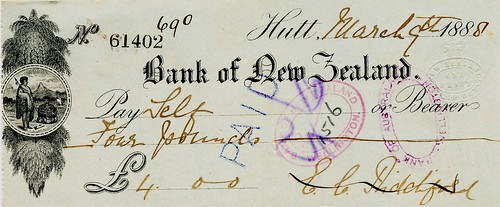
The BNZ was established in 1861 in Auckland, New Zealand, with a branch estd. in Wellington in 1862. The Hutt Valley is an area just outside the capital city of Wellington. Notes : there is a blind-embossed oval with crown beneath the date showing “New Zealand Stamp Duty One Penny.” Two oval red ink stamp imprints ( a ) Bank of New Zealand Wellington and ( b ) Bank of Australasia Wellington. Cheque written for Four Pounds.
References: http://en.wikipedia.org/wiki/Bank_of_New_Zealand
http://www.bnz.co.nz/about-us/history
02 : The Bank of Australasia. Wanganui. New Zealand. Chq No. 115 dated Sep 24th 1870.
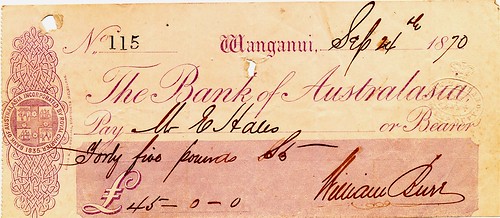
Wanganui is a city located on the banks of the Wanganui River on the West coast of the North Island of New Zealand, about 200 kms north of Wellington. In 1835 a London based bank called The Bank of Australasia was formed that would eventually become the ANZ Bank. Notes : there is a blind-embossed oval with crown beneath the date showing “New Zealand Stamp Duty One Penny.” Cheque written for Forty Five Pounds.
References: http://en.wikipedia.org/wiki/Banking_in_Australia
http://www.anz.com/australia/aboutanz/corporateinformation
03 : The Union Bank of Australia Limited. Ballaarat. Victoria. Australia. Chq. No. E34,860 dated June 22nd 1886.
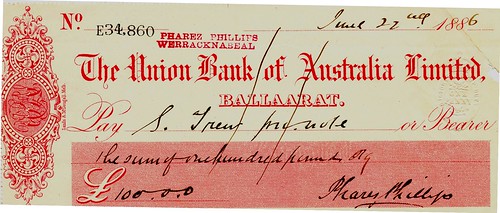
The Union Bank of Australia Limited was established in London in 1837 and officially opened its first branch in Australia in 1838 at Launceston, Tasmania. In 1951 it merged with The Bank of Australasia to form the ANZ Bank. Ballaarat, a city in Victoria, Australia, is famous for the Eureka Rebellion in 1854 by Gold Miners against the Colonial Authority of the United Kingdom. This cheque is quite interesting as it has a stamped name in red ( upper left ) Pharez Phillips Werracknabeal – research online indicates that Pharez Phillips was born 1855 in Victoria, was a Jewish Storekeeper & Farmer. Freemason. Member - Parliament of Victoria ( Minister without Office 1900-1901 )
References: www.australianstamp.com/coin-web/aust/notes/colonial/ubal.htm
www.parliament.vic.gov.au/re-member/bioregfull.cfm?mid=649
THE BOOK BAZARRE
MAO CHIN MARK MAKES A VALUABLE ERROR BANKNOTE
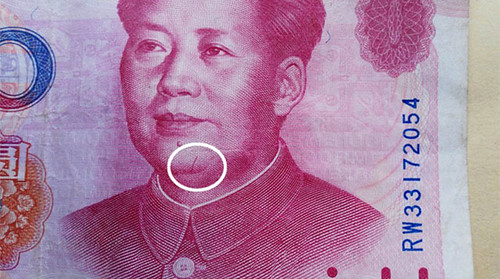
Loaded currency collectors may offer up to 1.5 million yuan to the owner of a 100-yuan banknote that's said to be incredibly rare due to a printing mistake—a tiny little line on Mao's chin.
The note has been verified as authentic, and the owner, a Chongqing man surnamed Zheng, said he received it with his usual wages pack. Zheng recently learned that a man in Guizhou had a banknote with a similar error worth one million yuan, so he posted pictures of his own bill online, China.org reports, citing the Chongqing Evening News. Several people expressed interested in buying it for a lucrative sum of money.
Experts at an auction house estimated that Zheng's imperfect banknote was worth up to 1.5 million big ones, although another auction house noted that because the bill was somewhat new (printed in 1999) he might not be able to fetch that much.
To read the complete article, see:
Flawed 100-yuan banknote found to be worth 1.5 million
RMB (http://shanghaiist.com/2015/06/04/flawed_100_yuan_banknote
_found_to_b.php)
2015 CURRENCY CONFERENCE A RETROSPECTIVE
 From the opening remarks by Mr. Richard Haycock, Chairman Currency Research (see video below)
and the Welcome Address from Ms. Carolyn Wilkins, Senior Deputy Governor Bank of Canada, it was plain that the tone of the conference would
be positive regarding the future of our industry.
From the opening remarks by Mr. Richard Haycock, Chairman Currency Research (see video below)
and the Welcome Address from Ms. Carolyn Wilkins, Senior Deputy Governor Bank of Canada, it was plain that the tone of the conference would
be positive regarding the future of our industry.
If the media hype and lobbying efforts surrounding alternate payment forms are to be believed, then one would expect a certain air of doom and gloom from the industry suppliers who sponsored the 2015 Currency Conference. I am pleased to report that not a single supplier I met during my exhibit floor walk-about was anything but enthusiastic for the future of banknotes and coins.
Of particular note were the exhibits by The Canadian Mint, The Royal Mint, Oberthur Fiduciaire, KBA NotaSys and SICPA who were proud to discuss their ongoing efforts for product improvement and displays of new hi-tech designs and authentication features. I walked away with a few samples of coloured coins from the Canadian Mint that are the envy of my friends and family.
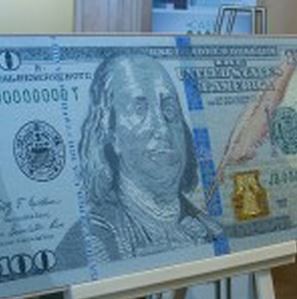 Of particular interest to this attendee was the panel discussion on Public Surveys and Perception
Studies. It was interesting to note the inclusion of more social media strategies in terms of reaching, listening to and understanding the
public’s perception on cash usage and it’s permanent role as a payment choice.
Of particular interest to this attendee was the panel discussion on Public Surveys and Perception
Studies. It was interesting to note the inclusion of more social media strategies in terms of reaching, listening to and understanding the
public’s perception on cash usage and it’s permanent role as a payment choice.
To read the complete article, see:
2015 Currency Conference A Retrospective
(http://countingoncurrency.com/news-item/2015-currency-conference-a-retrospective/)
G7 MINISTERS VISIT GERMANY’S ANCIENT COIN COLLECTION
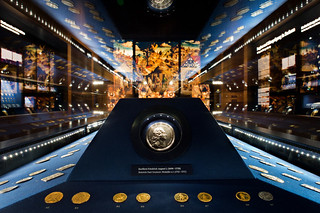 When
Germany’s Wolfgang Schäuble hosted the G7 finance ministers meeting last week, he had an unusual idea for how to entertain his counterparts
in between meetings. He asked them to join him in visiting a coin collection.
When
Germany’s Wolfgang Schäuble hosted the G7 finance ministers meeting last week, he had an unusual idea for how to entertain his counterparts
in between meetings. He asked them to join him in visiting a coin collection.
Their jaunt was to take place after a working lunch in Dresden’s Royal Palace on Thursday. It was early afternoon, 2:15 pm, and a handful of museum and government officials had already gathered in the Numismatic Cabinet which, as a part of the State Art Collections, is also located in the palace. They were waiting for Schäuble and others to arrive. But they didn’t know who the others would be because, as one nervous official put it, “you can’t really force a US Treasury Secretary to look at a coin collection instead of, say, going to his hotel room and phoning his wife.”
Though the event had initially been planned as a low-key affair — just some of the world’s most eminent finance ministers face-to-face with some of the world’s most eminent coins — a couple of journalists had been granted access, too. A team from the regional news network was battling a documentary filmmaker and an in-house crew over who would get to shoot the finance ministers looking at cash from the best angle. (Call it the money shot.) The regional news producer pushed her luck by suggesting that she needed an image of Schäuble “taking a coin into his hands.” The museum officials firmly told her that no such thing would be possible, insinuating the coins were too precious even for a German finance minister to get his hands on.
Visiting a coin collection may seem a little dull in comparison to other pastimes preferred by world leaders. George W. Bush invited state guests to barbecues on his Texan ranch. Boris Yeltsin asked fellow world leaders to join him in the sauna, Bill Clinton played the saxophone. But Schäuble’s choice of venue in Dresden did befit a summit that, according to the German finance ministry, was all about the question of how to reconcile growth policy with fiscal prudence.
The Dresden Numismatic Cabinet consists of four ridiculously high-ceilinged rooms, once inhabited by Saxon aristocrats, that were expensively refurbished for the sole purpose of exhibiting tiny coins. One Saxon Duke, George the Bearded, founded the Numismatic Cabinet in the 16th century. The collection has moved around a lot since then — it even spent some time in Moscow after Red Army soldiers seized it as a war trophy. As of this summer, the coins are back where they originally belong, and the cabinet will be reopened to the public next week. Since the federal government paid for some of the refurbishing costs, museum officials knew Schäuble well enough and invited him to visit during his stay in Dresden.
At about 2:30 pm, Schäuble moved briskly ahead into the cabinet lobby. He shook hands with Museum Director Hartwig Fischer and Cabinet Director Rainer Grund. He was given a coffee-table tome called “Competition in Ore: The Portrait Medal in the German Renaissance.” In return, he presented museum officials with a collector’s edition of ten German-made €2 coins. (The set sells for less than €50 on Ebay.) Fischer gave a little speech, mentioning that the collection consists of a total of 300,000 coins, most stashed away in metal cabinets. “300,000!,” Schäuble exclaimed, pursing his lips in appreciation.
Then the show began, starting with a commemorative medal that dates back to 1690. Its face depicts a Saxonian silver mine and a quasi-divine hand reaching down from the sky and presenting a coin. The image signifies that the value a silver mine depends on investments, Grund helpfully explained. He then moved on to Imperial Germany’s most expensive piece, a 3 Deutsche Mark coin celebrating the 400th anniversary of Martin Luther’s reformation and the exhibit’s heaviest gold coin (348 grams). Asked whether he expected the international finance ministers to learn something new, Grund said that he only wanted to “leave an impression of the beauty and diversity of this historical coin collection.”
The visitors then entered a dark room with a suspended ceiling and no windows; the part of the exhibit devoted to the history of money, from the ancient Greek drachma to the present-day euro. Schäuble asked to see the collection’s oldest piece and was shown a coin the size of a cufflink dating back to 600 BC. At this point, French finance minister Sapin came alive, showing numismatic expertise and pointing to exhibits he identifed as Lydian and Greco-Bactrian. “Une très belle collection,” he said, moving on to the next room. Other finance officials seemed less impressed. They huddled together at the other end of the room and laughingly pointed at a euro coin minted in Greece.
Only thirty minutes had been allotted for the tour — a tight schedule considering the history of money spans thousands of years. Grund managed to squeeze in two more objects before concluding the tour. The first, an early 18th century medal, depicted the Saxon king Augustus the Strong as Hercules fighting a many-headed Hydra. The other was a war medal donated by Frederick Augustus II, Elector of Saxony. Finance Minister Schäuble, who’d listened attentively until now, got impatient. He slapped his thighs and said: “Oh well, we have to go.” Five minutes later, no finance minister remained, and the coin cabinet was empty. The money show was over.
To read the complete article, see:
Schäuble’s coin cabinet
(www.politico.eu/article/g7-schauble-finance-ministers-visit-coin-cabinet/)
THE BOOK BAZARRE
EXHIBIT EXPLORES MEDALS OF LOUIS XIV
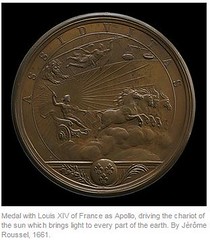
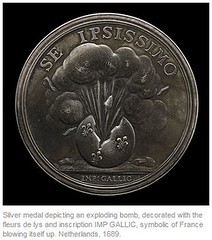
Louis XIV – known as the Sun King – was King of France for over 70 years, reigning from 1643 to 1715. In 1662 his Minister, Jean-Baptiste Colbert, put forward the idea of creating a series of medals commemorating the triumphs of Louis’ reign – a medallic history. This was to form an extraordinary work of collaborative art that resulted in a unique and fascinating self-portrait of the regime that dominated Europe for nearly 60 years.
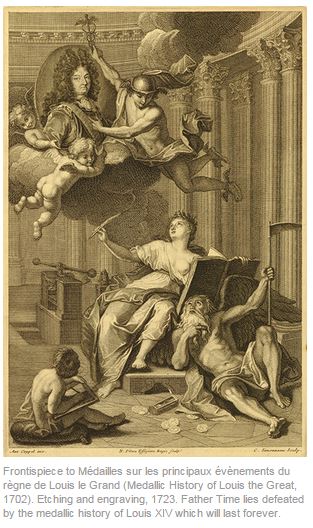 The display explores the background to the medallic history’s production, introducing some of the key
people involved in its design and execution, including Colbert, artist and sculptor Jean Warin and authors Charles Perrault (best known
today for his collection of fairy tales) and Jean Racine. The display uses a selection of the British Museum’s outstanding collection of
medals produced during this period to tell this fascinating story – from the setting up of a ‘Little Academy’ (a committee established in
1663 to advise Louis on commemorating his reign) to the process of creation and production, and how Louis was represented.
The display explores the background to the medallic history’s production, introducing some of the key
people involved in its design and execution, including Colbert, artist and sculptor Jean Warin and authors Charles Perrault (best known
today for his collection of fairy tales) and Jean Racine. The display uses a selection of the British Museum’s outstanding collection of
medals produced during this period to tell this fascinating story – from the setting up of a ‘Little Academy’ (a committee established in
1663 to advise Louis on commemorating his reign) to the process of creation and production, and how Louis was represented.
The show also includes a 1702 folio edition of the medallic history (Médailles sur les principaux événements du règne de Louis le Grand – essentially a catalogue of the medals that were produced) from the Department of Coins and Medals’ library collection. It is shown alongside two loan objects – a scrapbook from the British Library of ideas for medals in the form of sketches, descriptions and drawings by Sébastien Le Clerc, and an enamel portrait miniature of Louis from the Victoria & Albert Museum. Finally, a selection of satirical medals produced by Louis’ enemies in Germany and England represent responses to his medallic history.
To read the complete article, see:
Triumph and disaster medals of the Sun King
(www.britishmuseum.org/whats_on/exhibitions/triumph_and_disaster.aspx)
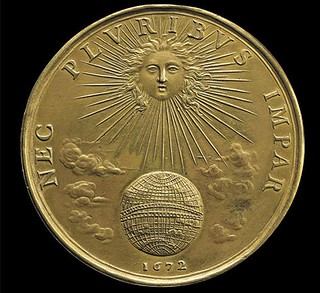
The great 1702 publication of the Medallic History, intended to carry its message throughout Europe was an immensely ambitious and luxurious publication: it even had one of the most famous of all typefaces, Roman du Roi invented for it. The volume opens with a frontispiece depicting Father Time, lying defeated by the medallic history which was intended to last forever. What survives today is a fascinating and unique self-portrait of a regime which dominated Europe for nearly sixty years, and which established the primacy of French taste and French culture for over a century.
To read the complete article, see:
Exhibition
at British Museum explores the 'Medallic History' of Louis XIV's reign
(http://artdaily.com/news/79057/Exhibition-at-British-Museum-explores-the--Medallic-History--of-Louis-XIV-s-reign#.VXF23s-6dhE)
KÜNKER 2015 SUMMER AUCTION HIGHLIGHTS
Rudolf II., 1576-1612. Reichstaler
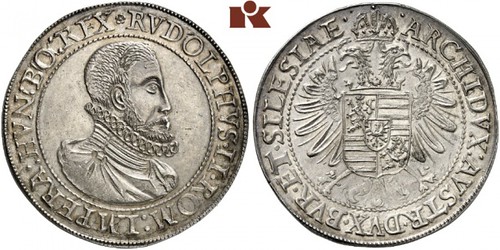
To read the complete lot description, see:
Rudolf II., 1576-1612. Reichstaler o. J., Breslau. 28.85 g. Dav. 80
(www.kuenker.de/en/auktionen/stueck/85280)
Anne, 1702-1714. 5 Guineas 1706
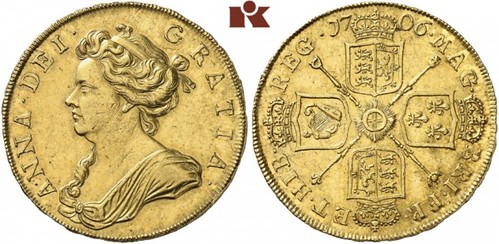
To read the complete lot description, see:
Anne, 1702-1714. 5 Guineas 1706 (5. Regierungsjahr), London. 41.
(www.kuenker.de/en/auktionen/stueck/85707)
Victoria, 1837-1901. Goldmedaille
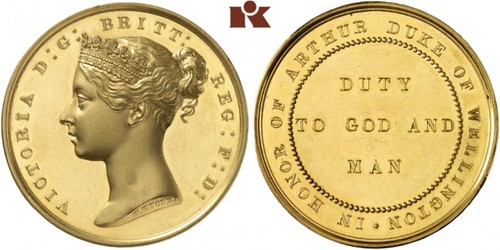
To read the complete lot description, see:
Victoria, 1837-1901. Goldmedaille o. J. (um 1850, graviert 1884), Ei
(www.kuenker.de/en/auktionen/stueck/89614)
Maximilian III. Joseph, 1745-1777. Goldmedaille
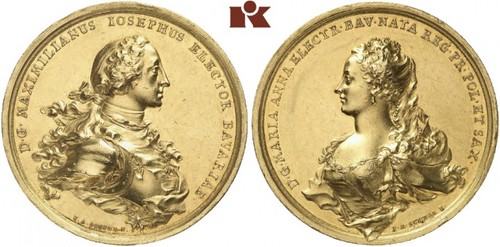
To read the complete lot description, see:
Maximilian III. Joseph, 1745-1777. Goldmedaille zu 50 Dukaten o.
(www.kuenker.de/en/auktionen/stueck/88783)
Friedrich August III., 3 Mark 1917
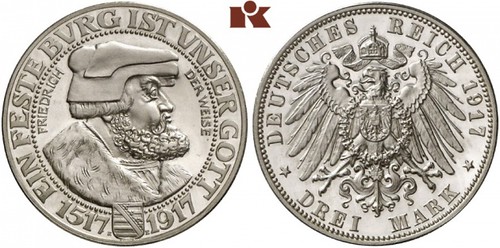
To read the complete lot description, see:
Friedrich August III., 1904-1918. 3 Mark 1917 E. J. 141.
(/www.kuenker.de/en/auktionen/stueck/91792)
For more auction highlights, see:
Our Summer Auction Sale 2015
(www.kuenker.de/en/auktionen/stuecke/263-264?filter=allehighlights)
CHINESE BUSINESS BUYS CAR USING 660,000 COINS
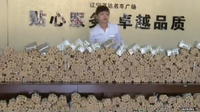 A Chinese man has paid for his new car using 660,000 coins and 20,000 low value banknotes, it's reported.
A Chinese man has paid for his new car using 660,000 coins and 20,000 low value banknotes, it's reported.
The buyer, identified as Mr Gan, handed over the huge haul of small change to a dealership in the northeast city of Shenyang, the Liaoshen Evening News reports. Each coin and note was worth just one yuan ($0.16; 10p), and the hefty sum, weighing four tonnes in total, took up more than 4m (13ft) of floor space within the showroom, the report says.
Mr Gan explains that he paid in cash because he had amassed a huge amount of small denomination coins and notes through the petrol station where he works. "As our station is in the suburbs, there are very few banks. So we didn't deposit the coins and decided to use them to buy a car for our company," he says.
The buyer warned staff at the car dealership in advance about his unusual payment method, and the cash was neatly wrapped in small packages. But it still posed a logistical challenge - employees needed more than an hour to move all the cash into the showroom. They then had the unenviable task of gathering it all up again and taking it to the bank.
To read the complete article, see:
China: Man buys car using 660,000 coins
(www.bbc.com/news/blogs-news-from-elsewhere-33008073)
FEATURED WEB PAGE: SCOUTING THEME MEDALS
This week's Featured Web Page is a 2003 blog post by Dick Johnson on scouting theme medals made by Medallic Art Co.Thousands of themes are found among the medals made by Medallic Art Company. MACO has made so many medals, in fact, that collectors recognize they cannot collect them all – although that could be a collectors’ specialty itself — collectors tend to specialize and collect by theme, which they call a topic. Collecting is a very personal thing – every collector chooses his own topic.
The scouting movement, for both boys and girls, has been well represented within the archives of Medallic Art medals. We do not know the creators of all the scouting medals, but some very prominent sculptors are revealed here, Paul Manship and Laura Gardin Fraser top the list. The appeal of scouting collectibles is very strong. Even more so for adults as reflects a happy time in their youth.
Many of these items were ordered continuously and bestowed to youths over a sustained period. Others, as Jamboree pins, were for only one event, one year. Medallic Art was a major supplier of these medallic items to the two scouting organizations.
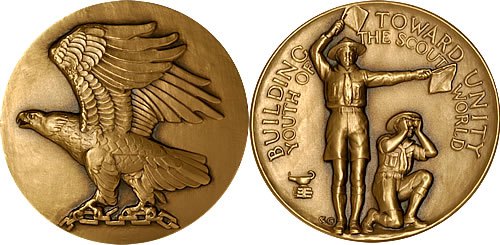
https://medalblog.wordpress.com/2013/03/02/
scouting-theme-medals-made-by-medallic-art-co/
